
Verify the Insulation Integrity of Electrosurgical Equipment
Verify the Insulation Integrity of Electrosurgical Equipment
Detect & locate defects such as pinholes, cracks and bare spots in the jacket or coating of laparoscopic and bi-polar electrosurgical instruments
Detect & locate defects such as pinholes, cracks and bare spots in the jacket or coating of laparoscopic and bi-polar electrosurgical instruments


INTELLIGENT SOLUTIONS FOR INSTRUMENT CARE & INFECTION CONTROL
INTELLIGENT SOLUTIONS FOR INSTRUMENT CARE & INFECTION CONTROL
HMARK.COM | 800.521.6224
HMARK.COM | 800.521.6224
Greatly Reduce Unintended Tissue Burns During Electrosurgical Procedures
Greatly Reduce Unintended Tissue Burns During Electrosurgical Procedures
The Insulation Tester tests for aws in protective coatings applied over conductive instrument surfaces in order to prevent inadvertent tissue burns, which may occur during electrosurgical instrument procedures.
The Insulation Tester tests for aws in protective coatings applied over conductive instrument surfaces in order to prevent inadvertent tissue burns, which may occur during electrosurgical instrument procedures.

For more of Healthmark’s intelligent solutions for instrument care & infection control, visit
For more of Healthmark’s intelligent solutions for instrument care & infection control, visit HMARK.COM
HMARK.COM
Lightweight Portable Unit Rechargeable Battery Simple Functionality Safe To Operate 1.1lbs LED Display & Indicators
Lightweight Portable Unit Rechargeable Battery Simple Functionality Safe To Operate 1.1lbs LED Display & Indicators
2 Publisher’s Letter: Challenging Ourselves to Solve Tomorrow’s Problems
4 An Evolution with Physician Engagement
Why physicians are valuable partners in operating the supply chain.
6 Cancer Control Month: Past, Present and Future
Raising awareness for cancer prevention and treatment through the United States
12 World-Class Emergency Services
Supply chain has played an important part in the building of UC Health’s new emergency department. It will play an even bigger role when the facility opens this year.
38 Addressing Caregiver Burnout
Why more positive point of care experiences for caregivers have never been more important, and the role equipment can play in improving those experiences.
42 Driving Value
HonorHealth’s Lisa Lavalette said value analysis teams are better equipped for today’s supply chain challenges.


44 Supply Chain By the Numbers
Facts and figures that highlight key supply chain trends.
46 Supply Chain Visibility
Enduring challenges require new approaches.
50 Healthcare GPOs: Evolving to Address Today’s Cybersecurity Challenges

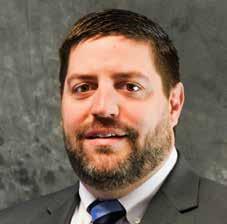

52 Industry News

The Journal of Healthcare Contracting | April 2023 1 APRIL 2023 Subscribe/renew @ www.jhconline.com : click subscribe CONTENTS Feature Future Leaders » pg20
Challenging Ourselves to Solve Tomorrow’s Problems
When asked what skills are most important to succeed today, William Brewer got right to the point for this issue of The Journal of Healthcare Contracting
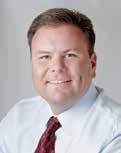
“Innovation,” said Brewer, enterprise vice president, supply chain management/GPO operations, Advocate Health. “Improvement requires innovation, which demands new ways of thinking, doing, and engaging across the value chain. If we are going to build a more resilient post-pandemic supply chain, we have to continually challenge ourselves, our teams, suppliers, and industry partners to think differently.”
I couldn’t agree more. The rate of change in our society and economy has gone from fast, to faster, to explosive. To solve today’s – and tomorrow’s – supply chain challenges, we’ll need new ways of thinking. And the only way for that to happen is to “get comfortable being uncomfortable,” as the leadership mantra goes.
Fortunately, I believe the U.S. healthcare supply chain is in good hands with who is helping to shape its future. For this issue’s cover story, we highlight several supply chain leaders who have a bright future ahead of them. How did they get into the field? How has their role expanded? What lessons have they learned in a pandemic and post-pandemic marketplace? We ask them all these questions and more.
Also in this issue, we examine why physicians are valuable partners in operating the supply chain, and how to get the most out of physician engagement. Plus, UC Health, a leader in emergency medicine, is expanding its emergency department footprint with a new facility. Supply chain played a key role in the facility’s development, and they shared with us their strategy for its planned opening in July, which is fast approaching.
Indeed, there’s no slowing down in today’s healthcare supply chain. We hope this issue gives you the tools and inspiration to drive innovation and solutions in your own team and organization.
The Journal of Healthcare Contracting is published bi-monthly by Share Moving Media 1735 N. Brown Rd. Ste. 140 Lawrenceville, GA 30043-8153
Phone: 770/263-5262
FAX: 770/236-8023
e-mail: info@jhconline.com
www.jhconline.com
Editorial Staff Editor Graham Garrison ggarrison@sharemovingmedia.com
Senior Editor Daniel Beaird dbeaird@sharemovingmedia.com
Art Director Brent Cashman bcashman@sharemovingmedia.com
Publisher John Pritchard jpritchard@sharemovingmedia.com
Circulation
Laura Gantert lgantert@sharemovingmedia.com
The Journal of Healthcare Contracting (ISSN 1548-4165) is published monthly by Share Moving Media, 1735 N. Brown Rd. Ste. 140, Lawrenceville, GA 30043-8153.
Copyright 2023 by Share Moving Media. All rights reserved. Subscriptions: $48 per year. If you would like to subscribe or notify us of address changes, please contact us at the above numbers or address.
POSTMASTER: Send address changes to Share Moving Media, 1735 N. Brown Rd. Ste. 140, Lawrenceville, GA 30043-8153. Please note: The acceptance of advertising or products mentioned by contributing authors does not constitute endorsement by the publisher. Publisher cannot accept responsibility for the correctness of an opinion expressed by contributing authors.
PUBLISHER’S LETTER JOHN PRITCHARD April 2023 | The Journal of Healthcare Contracting 2
Where care begins
While each patient journey is unique, medical diagnostics plays a crucial role in delivering data and actionable insights. At QuidelOrtho, we pride ourselves in providing these critical answers early and often in the healthcare continuum.
See what’s new at QuidelOrtho.com

AD10002900EN00 (12/22) Copyright © 2023 QuidelOrtho Corporation. All rights reserved.
An Evolution with Physician Engagement

Why physicians are valuable partners in operating the supply chain.
A career in healthcare supply chain allows for working with, learning from, and befriending a wide variety of people who contribute to care delivery in countless ways. Physicians are one of many groups of key stakeholders for the supply chain. Not only are physicians important when making certain product decisions, they are also valuable partners while operating the overall supply chain as a service.
It has been an interesting journey from how healthcare organization supply chains worked with physicians before COVID-19, how valuable it was to work closely together in the depths of COVID-19 and how those experiences are changing as we come out of the pandemic to enter our new normal. Physician engagement has numerous opportunities and is critical to the success of the healthcare supply chain.
Working with physicians has always been a rewarding experience for me and it has advanced in various healthy ways. For many years, most time spent with physicians involved engaging them to make selection decisions and contracting strategies for physician preference items. Influenced by COVID-19, physician engagement has evolved to affect different aspects of hospital and health system operations. This new and different engagement has had lasting positive results in these healthcare organizations and, specifically, for the supply chain.
By LeAnn R. Born, Founder and Advisor with LeAnn R. Born Advisory Solutions

Clarity to physician engagement
Prior to COVID-19, physicians were most involved with decisions related to the products they used. Products used in orthopedics, CathLabs, and general surgery were some of the main areas where physicians were asked to join value analysis teams. Through these teams, criteria about the products and services were established, options were reviewed, and savings was targeted through different sessions with suppliers. Results from this work helped many organizations achieve or exceed their savings performance goals. Standard processes used to make these decisions achieved successful outcomes and defined a certain role clarity for physicians.
Command centers of some sort were created by most healthcare organizations during the first weeks of COVID-19. Most of these command center teams included physicians serving in a variety of roles. By spending time together every day, supply
PHYSICIAN ENGAGEMENT April 2023 | The Journal of Healthcare Contracting 4
chain teams learned more from physicians about their needs and ideas while physicians learned more about how the supply chain operated the service. Mobile numbers were frequently exchanged for immediate communication needed to make urgent decisions. It might have been about expanding access to respirator masks or changing protocols for pre-procedure testing. As the urgency of these decisions diminished, the comfort with seeking advice through quick texts to the right people improved. Communication shifted toward general questions and updates like “there is a disruption that is going to limit our access to a product, who should we involve to decide how to manage the situation?” These relationships that were discovered or strengthened during COVID-19 are now contributing to broader involvement by physicians in the mission of supply chain departments.
COVID-19 experiences brought clarity to the different roles of physician leaders. Informal physician leaders and subject matter experts became more obvious. Many physicians expressed an interest to learn more about the supply chain and how they could be involved. Physicians now reach out with ideas and support for changes that could improve supply chain operations and financial performance.
Conversations worth their time
Throughout my career, I have always found benefit from asking physicians questions.
My observation has been that a lot of people, with positive intention, try to protect the time of physicians and make assumptions about what is important to physicians when they use products. At times, this limits how physicians are engaged. One of the biggest things I’ve learned, is to check with the physicians to see what investment of time they think is required and to always ask what is important to them.
My favorite example of this was when I sought perspective from a surgeon who many cautioned me to be careful around. I inquired about changing a product that many thought was taboo. His response was unwavering support for that change and awareness to another product that should not be changed. He brought to my attention the critical clinical details in that product that made it necessary when operating around a certain tissue. I would have never known about those critical criteria without that conversation.
Scheduling meetings with multiple physicians takes four to six weeks or more, but catching them quickly for a five-minute conversation can usually be done within a couple days. It became more obvious during the pandemic how to get the time needed to make decisions quickly based on the right information that physicians possess. It is common these days for agenda time to be offered for review of supply chain opportunities at medical staff meetings, eliminating the need for supply chain to schedule separate
meetings. There has been a transformation in the approach used when physician support is needed to make changes. In the past, it was common for the change to be presented with the savings potential as the reason. The newer approach is to be clearer on how the change will affect clinical practice. Opportunities that were resisted in the past are now better understood and, at times, it does not even affect how the physician delivers care.
This evolution in how physicians are engaged with the supply chain has resulted in more efficient decision making, broader ownership for product decisions, ease of making operational changes, and new sources of information to come up with better ways of providing the service. Physicians have even become involved in interview panels for leadership positions in supply chain.
The new normal of our supply chain should be learning from and taking advantage of the experiences we have had over time working with physicians. It continues to be important to invite physicians to regularly scheduled meetings using a standard value analysis process to make product decisions. Defined roles of physician leaders should be used to oversee these value analysis decisions. In addition to value analysis, physicians should be engaged to help with daily challenges and operational improvements. Seeking their ideas and support can expedite and add credibility to how the service is delivered.
LeAnn founded LeAnn R. Born Advisory Solutions, where she advises suppliers, providers, GPOs, and other industry partners about the healthcare supply chain. She helps clients drive strategies focused on improved population health, enhanced care experience, reduced cost, workforce well-being, and advanced health equity. Her background includes three decades of executive leadership of major health system supply chain services, program development with group purchasing organizations, and guidance to medical suppliers on effective sales strategies with customers. Before her consulting practice, LeAnn served as Vice President of Supply Chain at Fairview Health Services/M Health Fairview, Vice President of Contract, Program Services and Customer Contracting at Novation (now Vizient), and several positions leading up to interim Vice President of Supply Chain at Allina Health.
The Journal of Healthcare Contracting | April 2023 5
Cancer Control Month: Past, Present and Future
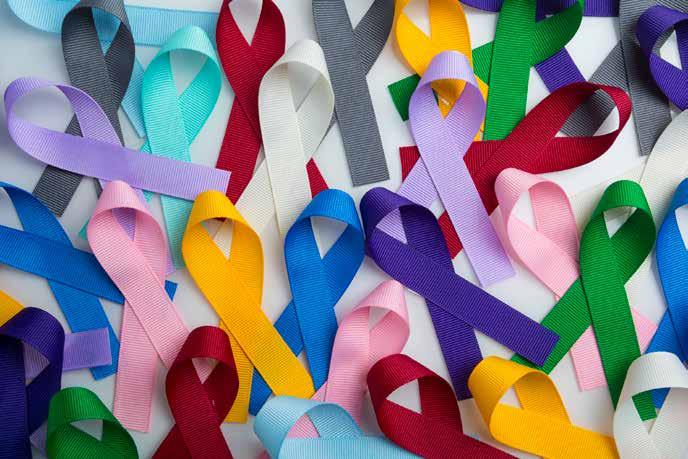
Raising awareness for cancer prevention and treatment through the United States
As the second-leading cause of death in the world, cancer is one of the few words in the English language that carries enough weight to stop a person in their tracks. It’s the kind of diagnosis that everyone takes seriously, because most of us know someone that has been affected by the burden of cancer. By recognizing and participating in Cancer Control Month, we can honor those who have battled cancer by finding new ways to reduce the burden that a cancer diagnosis causes.
The month of April is recognized as Cancer Control Month, which is dedicated to raising awareness for cancer prevention and treatment through the United States. In 1943, President Franklin D. Roosevelt found that cancer was a deadly enemy that took the lives of nearly 150,000 Americans each year. While the country was fighting abroad during World War II, President Roosevelt decided to start fighting cancer on the home front.
Roosevelt designated the month of April as Cancer Control Month in 1943, calling upon medical professionals, schools, universities, and media to join this movement. From there, he instituted an annual proclamation from the sitting president, calling on all Americans to pay attention to factors that can reduce individual cancer risk. Each year, the month of April is meant to honor the millions of Americans who are currently battling
TRENDS April 2023 | The Journal of Healthcare Contracting 6 BY PETE MERCER
The next generation in infusion management software is here.
DoseTrac® Enterprise Infusion Management Software

cancer, cancer survivors, as well as those that did not survive their fight with cancer by raising awareness about cancer prevention and the importance of continued research into better treatments.
Goals of Cancer Control Month
Despite the long history of Cancer Control Month, millions of Americans are still affected by the burden of cancer. The American Cancer Society estimates that 1.9 million people in the United States were diagnosed with cancer in 2022. This is not to say that we’re fighting a losing battle – in fact, a study conducted by The American Cancer Society found that there has been an overall drop in cancer mortality of 33% since 1991.
However, there is still plenty of work to be done. Because of the rates of positive cancer diagnoses, Cancer Control Month has five goals to shape the way in which it is enacted:
` Cancer prevention – According to the National Foundation for Cancer Research, about 30-50% of all cancer cases are preventable. Cancer prevention is a cost-effective, long-term strategy for controlling cancer through raising awareness, reducing exposure to known carcinogens, and equipping the population with the information they need to live a healthy life.
` Early detection of cancer – Early detection of cancer greatly increases the chances of successful, costeffective treatment. Early detection is a two-pronged strategy: education and screening. When people are educated about cancer risk factors and symptoms, they will better
understand the benefits of early detection. Screenings are the tests that determine whether an individual has cancer or not, usually before the onset of symptoms. Screenings are preventative measures like pap smears, mammograms, and colonoscopies that can assess the likelihood of cancerous cells forming.
` Improve cancer treatments –Not all cancer is preventable, so we need measures to improve existing treatments and source the development of future treatments. Chemotherapy is a common and effective cancer treatment, but the success rate of chemo depends on several factors. This is a harsh treatment that causes significant side effects, necessitating more research to provide better methods to treat cancer patients.
` Increase survival rate of cancer –Research is the key to increasing the survivability of cancer. Without the copious amounts of research that scientists have done over the years, a cancer diagnosis would be much bleaker than it is now. Research has provided answers to some of our biggest questions regarding cancer over the years – more importantly, research provides hope to the millions of Americans facing a cancer diagnosis.
` Improve quality of life – Cancer is difficult. It’s a hard diagnosis to live with physically, mentally, and emotionally for patients and their loved ones. No one gets out easy, and it’s a lot to process on both sides of the diagnosis. This is where reducing the burden of cancer becomes a sort
of call to action to support patients and their loved ones during this difficult season.
One year anniversary of Cancer Moonshot reignition
The Cancer Moonshot is an initiative launched by former President Barack Obama in 2016 in an effort to cut the death rate from cancer by 50% over the next 25 years, while improving the experience of the people and their families living with cancer. In 2022, President Joe Biden reignited the Cancer Moonshot initiative to continue to work towards the mission to “end cancer as we know it today.”
“The progress we’ve realized to date in understanding and achieving better outcomes for the more than 200 diseases known as cancer is inextricably linked to the collective investment and dedication of the government and the private sector working side by side,” said Dr. Karen E. Knudsen, chief executive officer at The American Cancer Society.
This commitment from the government works to shine a light on the disparities and shortcomings that exist in the current system, giving experts hope that more can be done to fight the burden of cancer on every front. Lisa Lacasse, president of ACS CAN, said, “We call on lawmakers and policymakers in Washington and every state across the country to continue to pick up the mantle and play an instrumental role in reducing cancer incidence and mortality through investment in research, promoting evidence-based prevention, including proven tobacco control; advancing innovation in cancer screening and early detection; and reducing barriers to affordable, comprehensive health care from prevention through survivorship.”
TRENDS April 2023 | The Journal of Healthcare Contracting 8
WELCOME TO THE HEART OF BAXTER




















Previously branded as Welch Allyn, Mortara and Burdick, the same reputable devices are designed to help meet the demands of high-volume ECG workflows in both acute and primary care environments. Leverage both cardiology devices and software solutions within your departments for efficiency and connectivity from ECG acquisition to the EMR.






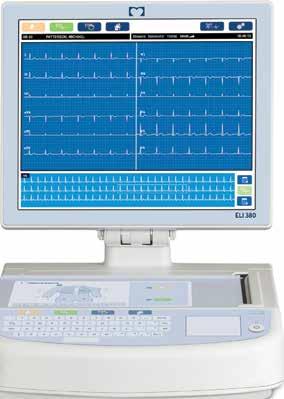
ELI 380 Resting ECG















Cardio Server











LEARN MORE ABOUT OUR SIMPLE, SECURE, AND CONNECTED SOLUTIONS





































01101010111100001001010101110100010111000111111100000010111001001010011000000 111001011110111001111111110000100110000010110100100100101100110101101101111000010 011110000100110100101111111101100110110011101100110000010110001111000111100111011 010110011101010100111100100001000000011000011100010001111010110000110011011000110 1000000001101011101111011101101111 111000010000101000011000011100
000100100010101001111101011001010111111101100110000001011011100100101110011100010 001101011110100111010110101010000010110010100110100011001100011101100101110111111 010110101101000111011010101001111000010101001101011111001110001001100000011110001 011001001001000100000110101010011000000110000101110111000001010001010010001111011 011111000101010010100011000011101110111000110001011010100100111110110010110001000 100101101011000110010010010111010001100011010001001101010101010000011000110100000 110010010000110101000111010110001001110001001110101100110000010001100110100001 01111111000010101110010010011111100000111111010011111011000010100010111001 1110011010000001100001010011101110101110010100011001100001110001000100 101001010000100001011000011100001110010110101110100111001001010000 11001010000100000010001000110111100011010100100011010111110110 0101111010001000100101011000000011101111110010010110011001 011101011010001011010101100010000010010001101011101000 11010011000010010100010000010110101001111000011100 1110000000010111010100000101010101010010111001 111111011010110010101101101111100010111111 00101100100100110001001100101011011000 11110000011001010001000011 1001101011111111010010 111111111100101000 10100101101101 10110101010 1101010 000
1001101000111000000100100110001110010111111000010011011111 11100010111111010101010011001011000110101101000100101100101010 010001000010001011010010111111000010101010001000100001110001101011 1110101101100000001111100011110011010011000101010100000101100011111001 1000011111011100110001010111111101010011001001001001111000010010101000010 1011100101110110 11001101010010010000 100101110100100001011011011011101101010001111100010 010101000100001001001011111000011000000000011101011100 ELI 280 Baxter.com Baxter International Inc. Baxter, Cardio Server, Diagnostic Cardiology Suite, and ELI are trademarks of Baxter International Inc. or its subsidiaries. ALL RIGHTS RESERVED. US-FLC50-230005 Ver 1 03/23
The American Cancer Society and The American Cancer Society Cancer Action Network are supporting the Cancer Moonshot’s five priority areas:

1. Close the screening gap
2. Understand and address environmental exposure
3. Decrease the impact of preventable cancers
4. Bring cutting-edge research through the pipeline to patients and communities
5. Support patients and caregivers
While recent reports from The American Cancer Society have shown the incredible progress we’ve made since the 90s, it also found that there is a stark disparity in cancer burden between men and women. From 2012 to 2019, there has been a significant drop in cervical cancer rates in women (ages 20-24) after the development of an HPV vaccine.
Rebecca Siegel, senior scientific director, surveillance research at the American Cancer Society and lead author of this report, said in a media release, “The large drop in cervical cancer incidence is extremely exciting because this is the first group of women to receive the HPV vaccine, and it probably foreshadows steep reductions in other HPV-associated cancers.”
Conversely, prostate cancer increased by 3% every year from 2014 to 2019, after a two-decade long period of decline. Alarmingly, much of this increase was driven by the diagnosis of advanced-stage prostate cancer. The report says, “Since 2011, the diagnosis of advanced-stage (regional- or distant-stage) prostate cancer has increased by 4% to 5% annually and the proportion of men diagnosed with distant-stage disease has doubled.”
“The increasing percentage of men presenting with advanced prostate cancer,
which is much more difficult to treat and often incurable, is highly discouraging,” said Dr. Knudsen. “In order to end cancer as we know it, for everyone, it is imperative for us to focus on cancers where trends for incidence and mortality are going in the wrong direction.”
Because of this increase in prostate cancer, The American Cancer Society is launching a new initiative called IMPACT or Improving Mortality from Prostate Cancer Together. The report says that IMPACT is designed to eliminate barriers and address needs to ensure that everyone has the same opportunity to be healthy and cancer-free by funding research programs, as well as funding additional programs
to enable the expansion of patient support to facilitate access to quality prostate cancer screening and care.
Additionally, IMPACT will help advance public policy designed to directly address the burden of prostate cancer. Dr. William Dahut, chief scientific officer for The American Cancer Society said, “We must address these shifts in prostate cancer, especially in the black community, since the incidence of prostate cancer in black men is 70% higher than in white men. IMPACT will fund bold new cancer research programs that connect the laboratory, the clinic, and the community. These studies will help discern who is most at risk for prostate cancer and how to prevent it.”
TRENDS April 2023 | The Journal of Healthcare Contracting 10
The American Cancer Society estimates that 1.9 million people in the United States were diagnosed with cancer in 2022. But a study conducted by The American Cancer Society found that there has been an overall drop in cancer mortality of 33% since 1991.


World-Class Emergency Services
Supply chain has played an important part in the building of UC Health’s new emergency department. It will play an even bigger role when the facility opens this year.
Emergency services are a big part of UC Health’s legacy. The UC Department of Emergency Medicine is home to the first residency training program in the U.S., and the program celebrated its 50th anniversary in 2020. The department attracts top medical students from across the country to train in Cincinnati, and its faculty are national leaders in clinical teaching and research.
` Renovate the existing 35,000-squarefoot ED to provide additional emergency response ability and “surge” capacity for emergency and crisis situations.
` New construction of three additional floors above the new emergency department to accommodate an observation unit, a flexible ICU and a new 28-bed unit.
` New construction of a four-story surgical building that will expand surgical capacity at the hospital, adding eight new operating rooms as well as new waiting areas and pre-operative clinics.
During the design phase, UC Health leadership that included supply chain and clinicians took a few trips across the country to look at best-in-class emergency department set ups, including Mayo Clinic, to determine how they wanted to set up their facility.

When UC Health got the greenlight to build a new facility for its emergency department from the ground up, leadership wanted the physical building to match their top tier ranking from a clinical perspective. To do that, they needed supply chain to play a key role.
The project was announced in October 2019. Ground was broken on the structures in late summer 2021, and completion
is expected in late summer 2023, according to the IDN. The project includes:
` Expand the UC Medical Center Emergency Department (ED) onto a previously vacant lot adjacent to the hospital. The 41,000-square-foot addition will significantly improve capacity and patient flow, including reconfigured access for patient arrivals via ambulance and private vehicles.
From a supply chain perspective, it was beneficial to be included early in the process, said Harold Dillow, assistant vice president of supply chain for UC Health. He has spent a lot of time with the emergency management service line people that represent College of Medicine, emergency management physicians, and then with UC Health’s own nursing administration that runs the ED to better understand what their expectations are for a bestin-class ED, and how the supply chain would service them. There are monthly meetings between supply chain, ED leadership that includes nursing and College of Medicine representatives, and a consultancy agency quarterbacking the process to talk about the progress of the project.
MODEL OF THE FUTURE
April 2023 | The Journal of Healthcare Contracting 12
BY GRAHAM GARRISON
From theoretical to actual UC Health’s current service model involves stocking a supply room in a couple of areas in the ED. Clinicians, nurses or technicians retrieve the supplies on their own. In the new ED, clinicians would like supply chain to provide everything they need at the point-of-use of where the care is being delivered, so the clinical person never has to leave patient care area or the “bedside”. It takes resources, more staff members and a new supply stocking strategy that UC Health’s team has been developing to be ready to roll out when the new ED is scheduled to open in July 2023. “It is fundamentally different than how we do it now,” Dillow said. “Now they retrieve supplies as opposed to us putting it at their fingertips.”
UC Health is developing an exchange cart process for the new ED. The concept is to always have supplies as close to full for the clinical team. Every single ED bay will have a cart stocked according to what the clinicians think would be the most used products at appropriate par levels. To stock the carts for the entire ED, supply chain will be allocated a large supply room in the middle of the space. The new ED is roughly the same number of rooms, but double the footprint.
“We have a lot of input on the design of the supply room because we want it to be big enough to not only have our inventory system hanging on the wall, but also space in the middle for the exchange carts to be restocked,” Dillow said. “We can take a full exchange cart, go to a room and grab one that’s been used and put the full one in. Theoretically there’s always plenty of supplies in every single room.”
Some parts of the process are already in place. For instance, last April, UC
Health implemented a new point-of-use inventory management system that tracks supplies better and reorders with RFID technology. It’s a much more efficient way of reordering supplies, Dillow said. “So, setting up a best-inclass process and then layering on some technology we think is going to be a really awesome combination.”
and the visual cue to let everyone know that a cart’s been used,” Dillow said. “Those are the granular types of decisions we’re figuring out so it can flow as smoothly as possible.”
Dillow said he’s excited to see the efficiencies gained from the new model. The estimated increased bedtime for clinicians alone was high enough to get a healthy

Supply chain is working on a myriad of small details for the new ED, such as the routes they would use to stock rooms, and when they would do it, so they’re more offstage from the public. They’ve worked on where the carts are going to be staged in the rooms, and will eventually focus on the individual items the clinicians want in the carts.
“We’ve even gotten it down to what color handles should be on the carts,
FTE approval to build up the supply chain team in the ED for 24/7 across three shifts. “The goal is to have everybody practicing at the top of their license,” he said. “The nurses and physicians can be honed in on what they’re doing to help the patient as opposed to worrying about grabbing supplies. There’s going to be huge intangible cost savings, but more importantly real savings for the patient care time.”
Recent successes
The supply chain team has been quite busy over the last 12 months, and not just on the new ED rollout. Recent accomplishments include:
` Managed through the highest surge of pandemic and ongoing global supply disruptions while supporting clinical operations. “Many in the industry experienced this the past few years, but it is worth recognizing our supply chain team’s extraordinary
The Journal of Healthcare Contracting | April 2023 13
It’s hard to reflect on the last few years and not think about battle scars, Dillow said. However, the challenges presented during the pandemic and staffing crisis have silver linings.
Harold Dillow
effort to deliver quality products in a timely manner with the odds stacked against them,” Dillow said. “While many items were procured via alternate sources or had to be converted, which resulted in clinicians having to use non-preferred product, we had great partnerships with the clinical team.”
` Reduced capital investment for instrument purchases to support the new surgical building. Supply chain and UC Health’s Perioperative Leadership Team partnered to calculate current instrument utilization and compare that to expanded case volumes to ensure only needed items were purchased.
` Simultaneously implemented two technology systems. UC Health chose to perform an ERP conversion and MMIS/WMS conversion at the same time. “I will say it was very difficult to implement two systems concurrently, but the team put forth an exhaustive effort to accomplish this goal,” Dillow said. “These new platforms enable us to gain efficiencies from automating processes that have traditionally been manual work. We intentionally refined and documented our manual processes so that we could layer on technology that would take us forward and not just be an expensive program built on inefficient, legacy processes.”
` Completed a GPO RFP. This was a large initiative that required strategic alignment across several departments (Finance, Supply Chain, Pharmacy) and included clinical partners.
“The result was UC Health selecting a GPO partner that most closely understood our needs as a health system that
includes an AMC and community-based acute care hospitals and large ambulatory footprint. This will deliver the highest quality contracts and products, and largest savings opportunities for UC Health.”
Navigating conversations with physicians
Another major achievement was managing through an extreme staffing crisis in Sterile Processing Department (SPD) where a large portion of the staff was recruited away for agency staffing companies. This directly impacted SPD’s ability to meet instrument tray demand for OR cases, Dillow said.
As a result, the SPD tray backlog, which is an indicator of SPD’s throughput and ability to provide on-time service, soared from a historical average of 50 trays to approximately 500 trays. Supply chain and PLT met multiple times per week for several months to jointly address the issue. A shared staffing model was implemented as an interim countermeasure as well as OR capacity management to ensure all scheduled cases were cared for. These interventions, combined with a coordinated recruiting effort with HR, resulted in the tray backlog returning to under 50.
“Over the last five to six years, supply chain has aligned and clinically integrated with our physician partners across all service lines,” said Dillow.
He said the springboard for this elevated engagement and alignment occurred because of their participation and involvement with the value analysis program and department specific product / implant standardization and savings initiatives related to:
` Ortho Trauma implants.
` Cardiology – CRM / DES.
` Ortho Total Joints.
` ENT – Cochlear implants.
` Cardiovascular – Heart valves.
` Radiology – Peripheral vascular products.
` Ortho / Neuro spine implants.
Building trust through transparency and partnership with aligning clinical quality needs and outcomes with cost efficiencies has been one key to success. No silo product decisions or changes without alignment of providers has been another key. Supply chain has also partnered with the chief medical officer to appoint a medical director for supply chain. “This has really helped navigate conversations with physicians and gain buy-in for service line product strategy.”
Adapting to new realities
Heading into 2023, supply disruptions and staffing availability remain challenges to address. “The pandemic largely focused on PPE items,” Dillow said. “Once those were secured, it was really about operationalizing the stocking strategy needed to support COVID care.”
But since then, global supply disruptions are affecting a much broader portfolio of products. “There’s almost no category that isn’t affected. Who would’ve thought crutches, of all things, would ever be an issue? That’s just one example of many.”
Because of this, UC Health’s sourcing and procurement teams have experienced a 900% increase in backorders. “The constant management of alternate sourcing and related logistics is very time consuming, and quite frankly, frustrating for the team.”
Once you get the product, there is the additional worry of appropriate staffing levels needed to manage the inventory.
MODEL OF THE FUTURE April 2023 | The Journal of Healthcare Contracting 14























































































































































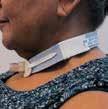
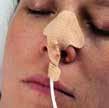


Represented Nationally by: Endotracheal Tube Holders Hold-n-Place® Foley Catheter Holders IV-ARMOR® ACE Connectors® Abdominal Binders Post-Surgical Bras Tracheostomy Tube Holders NasoGastric Tube Holders Bendable ArmBoards Transducer Holder Dale, Hold-n-Place, ACE Connector, and IV-ARMOR are registered trademarks of Dale Medical Products, Inc. ©2023 Dale Medical Products, Inc. All rights reserved. AD-100 Rev G WHY CHOOSE DALE? QUALITY YOU CAN COUNT ON Established in 1961, Dale is recognized as a trusted manufacturer of specialty medical devices that provide high quality, reliable, cost-e ective solutions to enhance patient care. dalemed.com/virtual-medical-center Visit the Virtual Dale Medical Center to see our products by specialty ENTERAL RESPIRATORY VASCULAR UROLOGICAL POST SURGICAL Visit dalemed.com for more information
In the case of SPD, its staffing needed to build case carts to support the OR.
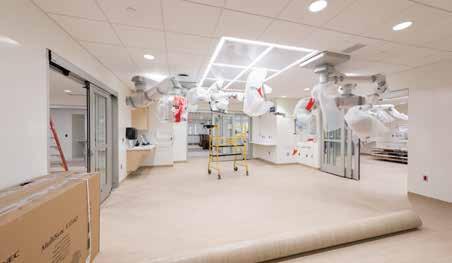
It’s hard to reflect on the last few years and not think about battle scars, Dillow said. However, the challenges presented during the pandemic and staffing crisis have silver linings. “We had to quickly adapt during those times to survive, and the key to surviving resulted in doing things differently.”
Although UC Health continually stress tests its processes to find improvement, those test scenarios simply didn’t include a once-in-a-century pandemic or having such a staffing deficit. So they adopted innovative ideas from their teams to create better processes and standardized those efforts where they made sense to carry on. “As a result, we have a better understanding of our end-to-end operations with process maps created because of the need to increase the speed of
communication amongst supply chain teams, suppliers, and clinicians.”
UC Health also consolidated many reports and data sources that different supply chain leaders were using to manage the business. Now there is one source of truth that pulls together inventory
Recent Achievements
Patient safety
UC Health’s sterile processing department (which reports to supply chain) has consistently averaged less than one patient safety issue per month reported in its clinical quality database. “This is an enormous achievement considering the average was 160 issues/month in 2017. This continues to be the most important initiative we focus on and measure.”
Supply savings
Since 2016, UC Health’s supply chain has delivered an ROI of 8:1 when comparing achieved savings versus team investment. “In a world of financial uncertainty, supply chain is uniquely positioned to be one of very few departments that can deliver that type of value to the organization,” Dillow said. “There is a tremendous amount of work and crossteam collaboration within supply chain and with clinical
levels, sourcing notes, and procurement information to make educated decisions based on a complete picture. “Lastly, we now have increased automation and data visibility that helps us be more proactive decision makers instead of always reacting and firefighting,” Dillow said.
partners to develop strategy and execute projects that deliver these savings. I am extremely proud we continue to deliver year-over-year results to UC Health.”
Diversity spend
One of the UC Health system-wide strategic pillars is “Community Commitment.” Embedded within that pillar is a goal to improve the economic vitality of local businesses, Dillow said. To achieve this goal, UC Health has an objective to increase women- and minority-owned enterprise spend to 6% by 2025, which is a 1% increase over the current goal. “To meet this goal, we have a well-developed Diversity program within supply chain that leads to engagement with community partners. Not only do we routinely host a forum open to the public that connects diverse vendors with UC Health leaders, but we also invest time in diverse supplier development.”
MODEL OF THE FUTURE April 2023 | The Journal of Healthcare Contracting 16
Understanding the Differences
Why one supply chain leader believes knowledge of the unique needs and workflows in the non-acute space is a tremendous help in navigating supply chain disruptions.
Mona Clark, AVP, Ambulatory Quality, Lifepoint Health, is a nurse by trade with 25 years of experience who has practiced in both the acute and non-acute settings. Her role at Lifepoint is focused on leading strategic initiatives and quality for the organization’s Physician Services team. Prior to March 2020, the primary focus of her position was on quality as it relates to value-based contracts, and her supply chain involvement was related to point of care testing in our practices.
However, when the pandemic hit, it was quickly identified that Lifepoint needed someone to lead its practices through all the supply chain issues they were experiencing at that time.
“The task was handed to me, and it was my first in-depth experience with supply chain management,” Clark said. “Although the supply chain aspect of my role has transitioned out of crisis mode today, it has evolved into a more stable focus on compliance, standardization and optimization, and I have continued taking on the responsibility ever since.”

The Journal of Healthcare Contracting | April 2023 17
McKesson
Sponsored
In the following interview, Clark discusses the benefits of having a dedicated non-acute supply chain team, planning for the unpredictable, and increasing diversity spend.
Why do you feel it is important for health systems to have a dedicated team that focuses on non-acute space?
There are significant differences between acute and non-acute spaces, and having someone dedicated to non-acute that understands the unique needs and workflows is a tremendous help in navigating supply chain disruptions.
On-site laboratory testing is a prime example of one of these specialized areas and is important in providing the best care to our patients. There are many unique challenges within non-acute settings that are not experienced in the acute space such as multiple locations and specialties being geographically spread out, as well as limited storage space within the practices.
How do you prepare and plan for the unpredictable?
The best way to prepare for the unpredictable is to partner with your distributor and leverage their insight into what they are hearing; conduct your own research into shortages and disruptions; and prepare to pivot quickly when needed. We have gained a significant amount of knowledge based on our experiences through the pandemic and need to take those lessons learned and apply them to everyday processes to be better prepared for uncertainties in the future.
Are you stockpiling through a private warehouse or distribution partner? Is this a priority?
We have stockpiled in the past and continue to monitor the situation. Throughout the pandemic, we relied on a centralized warehouse as we worked to keep our physician practices stocked with the needed supplies to keep both our staff and our patients healthy and safe. The warehouse is becoming less crucial than it once was at the height of the pandemic, but we are still utilizing it to purchase in bulk when we see possible shortages on the horizon to ensure our practices have what they need when they need it.
Diversity, equity and inclusion (DEI) is very important to Lifepoint. We are not only looking at expanding our vendor diversity spend, but we are also looking at the products available to make sure we are including options that are inclusive, such as bandages that come in multiple colors to match different skin tones. We are currently going through a formulary review, and during that time, each product is evaluated on several categories including diversification classification.
We feel it is very important to increase our diversity spend and are actively working to do so as we navigate the
Is the risk of (expired product) worth taking?
You must have the resources to properly manage the stockpiled product as it relates to the expiration dates and clinic needs. We have worked closely with our distributor, vendor partners and the warehouse team to limit waste and utilize inventory prior to shelf-life expiration.
What actions are being taken with your health system as well as at site level to drive vendor diversity spend? How are you partnering with your supplier partners on DEI spend?
frequent supply chain issues. Since we are currently conducting a formulary review, it is easier to do both simultaneously.
Is there any advice you would give someone who may be starting a role like yours in a health system that may have not had this role previously?
I highly recommend developing a strong partnership with your distributor and a close working relationship. Ask questions of those around you who have been in supply chain and rely on their wisdom until you learn the language and feel like you can start navigating it on your own.
April 2023 | The Journal of Healthcare Contracting 18
Sponsored McKesson
We are not only looking at expanding our vendor diversity spend, but we are also looking at the products available to make sure we are including options that are inclusive, such as bandages that come in multiple colors to match different skin tones.
The
stakes have changed. It’s time to raise the bar.
The stakes have changed. It’s time to raise the bar.
In this post-pandemic world, uncertainty is the new normal. Being resilient and ever-ready have moved from aspirational to table stakes. And now — more than ever — you need a reliable partner to support you and your patients every step of the way. That’s why we’re redefining supply chain expectations.
In this post-pandemic world, uncertainty is the new normal. Being resilient and ever-ready have moved from aspirational to table stakes. And now — more than ever — you need a reliable partner to support you and your patients every step of the way. That’s why we’re redefining supply chain expectations.
From physician offices to surgery centers and patients’ homes, we tailor our breadth of offerings to create a unique roadmap that helps you build a resilient, high-performing supply chain.
From physician offices to surgery centers and patients’ homes, we tailor our breadth of offerings to create a unique roadmap that helps you build a resilient, high-performing supply chain.
Redefining partnerships
Redefining partnerships
We’re relentless about building trusted partnerships that make supply chain excellence and better health possible.
We’re relentless about building trusted partnerships that make supply chain excellence and better health possible.
Redefining patient-focused solutions
Redefining patient-focused solutions
We build customized solutions to help you improve operational, financial and clinical outcomes
Redefining world-class distribution
Redefining world-class distribution
— efficiently, effectively and on budget — so you can deliver better patient care.
Raising Supply Chain Expectations, so you can deliver care – anywhere.




We build customized solutions to help you improve operational, financial and clinical outcomes — efficiently, effectively and on budget — so you can deliver better patient care. Raising Supply Chain Expectations, so you can deliver care – anywhere.
mms.mckesson.com/HealthSystems
mms.mckesson.com/HealthSystems
We’re ready for the future — today. From global distribution to logistics services, we help you improve operational efficiencies across hundreds of micro supply chains, so you’re ready to take on any challenge.
We’re ready for the future — today. From global distribution to logistics services, we help you improve operational efficiencies across hundreds of micro supply chains, so you’re ready to take on any challenge.



April 2023 | The Journal of Healthcare Contracting 20
Future Leaders
Who’s going to shape the future of the healthcare supply chain? These leaders have the energy, dedication and courage to help innovate the industry.

The Journal of Healthcare Contracting | April 2023 21
Tonya Bonczak Director of Strategic Sourcing Henry Ford Health Detroit, MI

Please describe your career at Henry Ford Health.
I started January 2019 as the contract sourcing specialist in support of construction and facilities. In addition to the assigned responsibilities of the role, I began to develop and implement new processes and strategies to gain efficiencies in the construction sourcing space while ensuring Henry Ford Health made sound decisions. With this improved process, I was also able to efficiently manage suppliers and align strategic relationships to benefit the organization. In September 2022, I became director of strategic sourcing for construction and facilities. In my tenure at Henry Ford Health, I have been able to lead the sourcing of billions of dollars in construction and facilities projects.
What interested you about a career in healthcare?
The far reaching touch into the community and the impact that the industry has. I am driven by solving problems and making things better and that is what I see as the core of healthcare.
What do you like about working in the healthcare supply chain? Was it a position you sought, or found out about once you began working in the field?
I like that supply chain has a huge impact on patient care and the community it serves. I am not particularly motivated to be in the industry due to a particular position but because of the growth and impact that is possible, I hope to be a senior executive in the field one day.
In what ways has the supply chain changed over the last 2-3 years from your perspective?
The need to be proactive with the needs of stakeholders and the organization as a whole has become more prominent, and the need to push harder for innovative systems and approaches.
What are some of the big challenges your supply chain team is facing as we head into 2023?
Maintaining timely delivery of products and services. Due to the uncertainty of the global supply chain that still exists, it makes it challenging to properly prepare for solutions to make improvements.
What’s the most rewarding project you’ve worked on recently?
Destination Grand is an approximately 1.2 million-square-foot phase hospital replacement project that will also be accompanied by several additional auxiliary buildings that will support the hospital campus. I was able to be one of the instrumental team members to get the project off the ground. To date, I am still heavily involved in the continued development of the project.
Does your organization have a formal or informal leadership development plan? Have you had any mentors that have provided guidance?
My organization does offer leadership development plans. I have had mentors outside of Henry Ford Health that have provided guidance in developing my change management tactics and how to approach tough situations.
FUTURE LEADERS
April 2023 | The Journal of Healthcare Contracting 22
Dukal Delivers on Wound Care

>Applicators & swabs
>Bandages
>Burn care
>Casting
Serving US healthcare providers for over 30 years, Dukal’s trusted and extensive portfolio provides quality, cost-effective solutions to protect and manage a comprehensive scope of wound care needs. Traditional Wound Care Advanced Wound Care
Adhesive Bandages
>Dry dressings
>Impregnated dressings
>Medical tapes & adhesives
>Small procedure kits
>Wound closure
>Wound dressings
Antiseptic & Cleansing
Specialty Dressings
Tapes
Enhancing family and community health through affordable healthcare solutions. Health systems that work with Dukal are able to reduce overall product spend, maintain or improve quality, as well as improve overall fill rates in the categories we provide
>To learn more visit dukal.com
William Brewer
Enterprise Vice President, Supply Chain Management/GPO Operations Advocate Health Washington, DC

What interested you about a career in healthcare?
I was drawn to the healthcare field at a young age. In fact, I set my sights on a degree and a career in healthcare administration in my mid-teenage years and have never looked back. I have always believed the healthcare field to be a noble cause, in that it provides critical services to people and their families when they need it the most. The reality is, we all require healthcare services at some point in our lives; to be part of a field that supports people, both in times of happiness and in need, has always been what has drawn me. Whether it is in supply chain or working as a direct care provider, we all have a role to play in ensuring that we are providing the best service and experience to the patients that we serve.
What do you like about working in supply chain? Was it a position you sought, or found out about once you began working in the field?
During college I was fortunate to receive an appointment as an Administrative Intern at University of Missouri Healthcare. My preceptor was the VP of Supply Chain/Support Services. I recall stepping into the role for the summer knowing very little about supply chain and never realizing that it played such a critical role in the delivery of care. I was addicted from the start. And while I have had the
great fortune to work in many different roles during my career, they have always been connected to the healthcare supply chain. I have the same feeling now that I did then – supply chain remains as one of the most critical, and sometimes unappreciated, areas of the healthcare delivery system. Twenty years into my career, I am still learning something new every day and believe that we have a tremendous opportunity to continuously improve. Every day is different, and I love that.
In what ways has the supply chain changed over the last 2-3 years, from your perspective?
Without question, and as we are all aware, the pandemic exposed the weakness and fragility of the healthcare supply chain. It was one of the first times in the career of many supply chain leaders that our teams were put in the spotlight. While there were bumps along the road and we can all agree that there is much to improve, it was also the time in which leaders, teams, and staff came together under extraordinary pressure and delivered for our care teams, patients, and communities. Certainly, there were moments of stress and panic, but teams across the country delivered. I believe we still have a long way to go to take the lessons of the pandemic and ensure that we build a more resilient supply chain, but that work is ongoing, and I remain encouraged by progress across the industry.
What skills are most important for you to succeed individually and for your team to succeed corporately in today’s environment?
Innovation. Improvement requires innovation, which demands new ways of
FUTURE LEADERS
April 2023 | The Journal of Healthcare Contracting 24
Twenty years into my career, I am still learning something new every day and believe that we have a tremendous opportunity to continuously improve. Every day is different, and I love that.
Supply Chain Solutions That Balance Cost and Care




Urinary Tract Infections cost the U.S. healthcare system nearly ~$3 billion annually.1 Balancing these types of costs with patient care places pressure on procurement professionals. As a trusted partner and supplier of continence care products Hollister Incorporated is committed to addressing the burden hospital-acquired infections place on healthcare providers.
Support for hospital supply chain professionals, including reduction in storage requirements2, number of SKUs, waste and costs3
Providing clinician and patient support that improves the efficacy and efficiency of care
A diverse portfolio of innovative catheter products to meet the individual needs of your patients
Prior to use, be sure to read the Instructions for Use for Information regarding Intended Use, Contraindications, Warnings, Precautions, and Instructions. Rx Only. Hollister, the Hollister logo and VaPro Plus Pocket are trademarks of Hollister Incorporated. © 2022 Hollister Incorporated.

learn more visit hollister.com/en/continencecare 1.M. Zilberberg, MD, MPH, B. Nathanson, PhD, K. Sulham, MPH, 1427. Healthcare Resource Utilization During Hospitalizations with UTI in the US, 2018, Open Forum Infectious Diseases, Volume 8, Issue Supplement_1, November 2021, Page S796, https://doi.org/10.1093/ofid/ofab466.1619 2. Hollister data on file, ref-02883, May 2022 3. Hollister data on file, ref-02009, 2020. Financial estimates based on 2020 cost data
To
Making a difference in the journey of life.
= Hollister.
thinking, doing, and engaging across the value chain. If we are going to build a more resilient post-pandemic supply chain, we have to continually challenge ourselves, our teams, suppliers, and industry partners to think differently. Simply making minor adjustments and largely doing what we have always done will not create lasting and meaningful change. We need to build resiliency and lean into best practices from other industries, such as vertical integration and greater transparency. I challenge myself and my team every day to question the status quo to ensure that we are not simply repeating what is familiar. A well-run and robust supply chain will only come by thinking differently than we have at any point in the past.
What are some of the top priorities of your supply chain team for 2023?
While resiliency must remain top of mind, we also must acknowledge that
we are facing a period of further declining margins driven by soaring inflation and diminishing revenue. I fear that the path the healthcare industry is on, which has been accelerated by macroeconomic forces over the last 2-3 years, is becoming more and more unsustainable. As a supply chain leader, cost control and finding solutions to offset escalating raw material and transportation costs is my top priority. The industry cannot sustain 8-15% year-over-year increases in supply costs, which we have seen over the last 12-18 months. Suppliers and providers must come together and identify ways to create efficiencies and reduce costs. This also involves technology partners and GPOs. Reducing costs also requires us to ensure we are working closely with physicians and care providers to collaborate to reduce variation and costs while maximizing outcomes for our patients.
Does your organization have a formal or informal leadership development plan? Have you had any mentors that have provided guidance?
Yes, at Advocate Health we have several programs to develop the next generation of leaders in our organization. Supply chain is an area where I am very passionate about developing talent to carry the torch forward. I think much of our success is predicated on inspiring that future cohort of leaders. For me personally, I can trace much of my success to a few mentors that have helped to guide my career. My current leader is one of those mentors. We have worked together for over 15 years in a variety of capacities and at different organizations. As you can imagine, over 15 years we have both developed and grown significantly but I have always looked up to him and his steady, inspirational, and principled leadership is something I have always sought to emulate.
FUTURE LEADERS
April 2023 | The Journal of Healthcare Contracting 26
Suppliers and providers must come together and identify ways to create efficiencies and reduce costs. This also involves technology partners and GPOs.





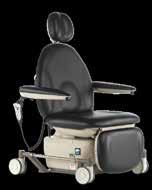






 Mark Carpenter Director, Regional Administration Cleveland Clinic Cleveland, OH
Mark Carpenter Director, Regional Administration Cleveland Clinic Cleveland, OH

What interested you about a career in healthcare?
I started my first job in healthcare as a freshman in college. One afternoon, I was in the hospital standing in the main lobby and watching all the people come in. There was a variety of people coming in and they all had different emotions. They were nervous, scared, hopeful or relieved. And while I’m not a clinician by trade, I help support the care for them by doing a behind-the-scenes operation. That could be me walking in the door or a family member or a friend. That energized me that day and I realized my purpose of being at work. It takes everyone to come together to provide that support and care for the patient. That’s something I fell in love within healthcare, and it grounded me. I’ve worked in a couple of different industries and felt like healthcare is where I could make a change.
What do you like about working in supply chain? Was it a position you sought, or found out about once you began working in the field?
I did a couple of different internships at Cleveland Clinic, and they were all on the operations side. One was with human resources. One was with protective services. They weren’t with supply chain, but I really liked working with Cleveland Clinic and when I saw positions open with supply chain that drove me into it.
In what ways has the supply chain changed over the last 2-3 years, from your perspective?
In the past 2-3 years, what’s changed in supply chain has been on the data front. We used to have a bunch of spreadsheets and massive databases, and what’s changed is that you need all that data right
now at your fingertips in a user friendly format. Something to easily understand with the ability to dive into the details and the complexities of supply chain. You’re leveraging that data to tell your story, to convey a message, to mitigate an issue or risk, or to make a decision. Having all of that at the forefront with Covid and having to make quick, rapid decisions reinforces that data-centric supply chain.
What are some of the big challenges your supply chain team is facing as we head into 2023?
Some of the challenges that you see all around are about product availability, whether it’s a shortage or backorder or on allocation. For us in supply chain, regardless of what’s happening, that adds more steps and delays to our supply chain. Those steps and delays cause additional stress and work for all of our employees. On top of that, you have the financial situation we’re all in now in that adds pressure to streamline operations and become more efficient. Mixing all of that together creates a challenging environment to navigate.
Some of the programs we’re trying to implement are better communication with our suppliers and distributors and getting that insight of when there’s going to be a disruption beforehand. Can we see some of their data insights and market intelligence to help us be prepared if we need to find an alternative supply? And we’re trying to keep them informed as well. If we have 27 cases scheduled for this month, we’re sharing that with the suppliers, so they feel that as well. There’s a human element in all of this. It’s not just ‘hey, I have an order and I need this product.’ There’s 27 people coming in for an operation and you
FUTURE LEADERS
April 2023 | The Journal of Healthcare Contracting 28
need to help us make sure we have those products available.
What’s the most rewarding project you’ve worked on recently?
We just wrapped up one of my favorite projects in March 2022 and it was opening Cleveland Clinic London. I led the project management arm of that for supply chain. It was Cleveland Clinic’s first hospital in Europe. It was a mix of bringing the best from Cleveland and the U.S. and the best from the U.K. and blending it together to make a state-of-the-art facility. It was a complex project. There were a lot of challenges and mitigations from external areas. For example, Brexit was in the middle of that and Covid was in the middle of that. We already had a challenging project in itself of building a new facility in another country, but then those other things layered in made the contracting and procurement that much more challenging. It was interesting for me, and I enjoyed that opportunity because I got
to meet people from all around the world and we could share and learn from each other. Everyone had a different way of approaching a problem from our different backgrounds. I lived over there for about six months.
Does your organization have a formal or informal leadership development plan? Have you had any mentors that have provided guidance?
Cleveland Clinic has a formal leadership development program. I was in a six-month course with leaders from the clinical side and administrative side and it brought us together as a cohort to develop our skills. We also had some service learning experience through volunteering in the community. That was really helpful, and I’ve paired that up with mentors that I’ve had so far in my career. One of the things I value from my mentors is having a sounding board and someone to talk a problem through. It’s always good to get someone
else’s perspective on a challenge and how they help you pick it apart and think of things you’re not seeing. I’m also lucky enough to have some mentors in different industries as some of the supply chain problems are all around. That gives insight into how another area is tackling an issue.
One of the big things I’ve learned from mentors and the program is “team of teams” and working with others. In my new role for our Florida region and abroad, we are connecting all of the different regions to our central enterprise. You’re never working by yourself. Even within supply chain, there are tons of different teams working through there, as well as teams outside of supply chain. There’s a mix of people in clinical and administrative in our Cleveland Clinic development programs and they put you through different situations to see how you will respond to it. It taught you real world experiences where you’ll work with clinical and administration and have to understand each other.
The Journal of Healthcare Contracting | April 2023 29
We already had a challenging project in itself of building a new facility in another country, but then those other things layered in made the contracting and procurement that much more challenging.
Eric Morrison
System Vice President, SSRM Operations CommonSpirit Health Denver, CO

Please describe your career at CommonSpirit Health. My career with CommonSpirit started in 2016 through legacy Catholic Health Initiatives when I had the opportunity to join the Texas division of Catholic Health Initiatives. It allowed me to take full ownership of the division’s supply chain operations and compete in one of the top markets for healthcare. It was my “if you can make it here, you can make it anywhere” moment.
At the time the Texas division operated as a group of individual hospitals, had poor quality outcomes, and was in financial turmoil. These challenges presented an opportunity to do better for our patients and the communities we serve throughout Texas. It also allowed me to reconnect with the ways in which supply chain can impact our caregivers and patients.
We put into place a playbook and set of standard procedures to begin operating as a division, rather than individuals. The work required support and significant change across a wide spectrum of stakeholders. It ultimately resulted in improved reliability and consistency of service – reestablishing confidence from physicians and clinicians in the supply chain. The newfound confidence brought both groups back to the table to support critical conversions and product standardization. The feedback allowed our physicians and clinical teams to have a direct connection to our contracting decisions, and the product standardization controlled supply variability to highlight deviations of care – improving quality outcomes. This approach drove cost out through the efficiencies gained by operating as a division and better controlling and enforcing our contracting decisions at the bin location.
The playbook and standard operating procedures developed in Texas were eventually scaled across legacy Catholic Health Initiatives. Many of the same operating philosophies are in place across CommonSpirit today and were critical to our success in navigating through the pandemic. My career at CommonSpirit has put me in a position to truly reconnect the supply chain to the patient.
What interested you about a career in healthcare?
Where most kids are searching for guidance on what they want to do with the rest of their lives, my mom helped shape and guide me by providing direction. My mom worked in clinical analytics and helped expose me to the industry. In high school she encouraged me to get a job at one of the local hospitals in Milwaukee. It was an opportunity to learn how hospitals operate and earn a little extra money.
Delivering meals for Food and Nutrition Services, I got a little insight into healthcare service delivery where you see patients at their highest highs and lowest lows. Each encounter was different, and I found it energizing to engage with patients around food. I wasn’t coming to run another test, or deliver bad news – just food of variable quality and possibly a distracting conversation that sometimes improved a long day of waiting and recovery.
You go through a lot of emotional moments when working in a hospital. I’ve seen honor walks, managed through the devastation of hurricane Harvey, and coordinated PPE needs for 145 hospitals throughout an unprecedented pandemic. It’s incredible to see people from all corners of life come together in these moments for a common purpose. I’m grateful my mom introduced me to healthcare,
FUTURE LEADERS
April 2023 | The Journal of Healthcare Contracting 30
but my continued interest in healthcare and pursuit to impact the industry positively is simple – it’s the people.
What do you like about working in the healthcare supply chain? Was it a position you sought, or found out about once you began working in the field?
The most intriguing aspect of being involved in healthcare supply chain is the complicated nature of our work. Healthcare is a large and complex network to operate within, and supply chain requires you to have knowledge of all aspects of the business – finance, accounting, operations, quality, contracting, human resources, etc. There is always a new challenge and opportunity we’re trying to solve, and no greater feeling than being successful and positively impacting and supporting the way our clinicians deliver care within our communities.
In what ways has the supply chain changed over the last 2-3 years from your perspective?
Over the past two to three years the supply chain has become more relevant. The pandemic has required both providers and suppliers to be better strategic partners – meaning transparency to improve resiliency. Data and the ability to leverage that information into quick actionable insights has become the new currency, and there’s been a prioritization of the conversation around risk.
Inflationary pressures have required providers to contract differently with more attention to the operational costs of an agreement. While price is an important aspect of a contract – we’re starting to see more of a focus on the mitigation of risk and total value when making awards.
What are some of the big challenges your supply chain team is facing in 2023? Labor – we need to invest in our people. We are competing for the same front line resources as Amazon, Walmart, etc. These associates are being compensated at higher rates, receiving additional incentives, and avoiding the risks associated with working in a hospital by pursuing opportunities in non-healthcare sectors. We need to find ways to improve our engagement and incentivize these associates to choose careers in healthcare supply chain.
At the leadership level, we need to find methods of recruiting and retaining top talent that will bring fresh perspectives and challenge traditional approaches. By having strong talent and an engaged workforce, we’ll be well positioned to tackle other over the horizon challenges facing our industry.
What’s the most rewarding project you’ve worked on recently?
The most rewarding project I’ve supported at CommonSpirit has been the development of our direct sourcing channels. The pandemic created the need for providers to have further visibility upstream into the supply chain. We went about developing a strategy with our caregivers and patients in mind. The question presented was – how could we improve product quality, resiliency and provide a financial benefit to CommonSpirit?
We leveraged strategic relationships, clinical advisory input and scale to pursue direct sourcing opportunities across certain product categories. We’ve been able to produce products with specifications determined by our clinicians and improved our visibility upstream by 180 days.
This work was championed by our Supply Chain Enterprises team, but took input and support from all of our work
streams. It’s been exciting to see the journey from identification of a problem to the development of product that now sits on the shelves of every hospital in our system.
Does your organization have a formal or informal leadership development plan? Have you had any mentors that have provided guidance?
I’ve found the most valuable leadership development has come through informal and organic relationships throughout my career. Some of this has come through direct reporting relationships, but more often than not, indirectly through others that have accumulated experience in the industry.
My drive has always come from wanting to be in a position of influence to positively impact the quality of service delivered to our patients, and acknowledging that it’s really difficult to be in those positions without a good support system. My mentors have different ways of managing and approaching situations, but are all people I respect and trust. Some manage with data, and others manage through relationships. It’s important to have mentors with diverse perspectives –tailoring your approach to suit your own personality and leadership style.
Other characteristics I would like to call out are that these relationships have been bidirectional and not always unconditional. I’ve found that people will invest in you to the degree that you work hard and are receptive to feedback. The most productive relationships are where both parties benefit professionally and a true friendship forms. It’s my opinion that it is when people become more vulnerable that trust forms, and you can really begin to learn from the experiences of others. That’s powerful knowledge when navigating leadership challenges.
The Journal of Healthcare Contracting | April 2023 31
Dasha Tretiu Director, Strategic Sourcing Novant Health

Kannapolis, NC
Please describe your career in healthcare. What interested you about a career in healthcare?
My first exposure to the local healthcare industry in Charlotte, N.C. was as a project manager for a group of Turkmenistan physicians, who came to our city to learn about evidence-based practices for disease management from local organizations. I attended multiple meetings with the group, learning about complexities of healthcare and what local IDNs are doing to improve the health of our community.
This initial experience led me to apply to UNC Charlotte’s Master of Health Administration (MHA) program. During my time in the program, I interned and volunteered at Novant Health in the supply chain department and when an opportunity to take on a full-time position opened, I started working at Novant Health as a supply chain data analyst.
Since then, I’ve worn many different hats, growing in my career while also gaining a lot of operational experience throughout the supply chain department. I was a contract administrator facilitating management of executed agreements. I was promoted to a senior financial analyst and focused on categorizing $300 million of spend data to facilitate data analysis and spend management. I spent seven years as a sourcing manager, driving clinical variation reduction efforts, identifying operational improvement projects and fostering cross-functional relationships to support our clinicians in their vision of delivering remarkable care.
Today, I’m a director of strategic sourcing. I support my team in managing physician preference contracts like neuro, ortho and HVI. I assist our product category leaders to achieve their goals, adapt to changing environments and remain
engaged in their job. We have a very senior group of team members in strategic sourcing – most have been in their role at Novant Health for over five years. There’s a wealth of knowledge and experience in our group, but the challenge is to continue to engage the team to ensure there’s no burnout. Even though we continue to face pressures to deliver exceptional savings value year over year, the team has time and again risen to the challenge and surpassed expectations.
do you like about working in the
What
healthcare supply chain? Was it a position you sought out or found out about once you began working in the field?
I like knowing that the work that we do is valuable. Even though we do not directly care for our community’s health, I know that our work is essential in making sure that our physicians and clinicians have the product and services that they need to treat those most vulnerable, while at the same time our healthcare system remains competitive in the market.
I learned about the strategic sourcing department while I was an intern at Novant Health. I was immediately interested and worked my way to being part of the team.
In what ways has the supply chain changed over the last 2-3 years from your perspective?
All supply chains faced unprecedented pressures with the COVID-19 pandemic over the last few years, but none more than healthcare supply chains. We had to mitigate unprecedented backorders, identify unconventional sources of PPE, and ensure that our teams are safe – all while caring for our communities.
FUTURE LEADERS
April 2023 | The Journal of Healthcare Contracting 32

DISCOVER DIFFERENCE the HealthTrust As the largest PROVIDER OWNED and OPERATED healthcare performance company, HEALTHTRUST PERFORMANCE GROUP is uniquely positioned as a partner to drive maximum value across major performance areas. healthtrustpg.com DISCOVER NOW! bit.ly/discover-ht-now Supply Spend for Non-Acute Care Labor Purchased Services Supply Spend for Acute Care
In general, supply chains are becoming more automated so there’s a lot of investment in technology and raw materials. Products are becoming more expensive, so there’s added pressure to reduce expenses. And the legal and compliance landscape is becoming stricter and more demanding.
We are all facing barriers to an efficient operation. Certain lean operation practices don’t work in healthcare anymore because we cannot end up in a situation where we don’t have enough supplies to care for our patients. Overstocking in certain instances is driving up demand and consequently prices.
In our supply chain, we used to advocate for vendor market share commitment and standardization to drive out variation and get more aggressive prices. But today, with so many backorders across multiple service lines, we can no longer accommodate that practice, so we are changing the way we contract. Unfortunately, vendors are not always supportive of multi-source contracts when they used to enjoy majority market share in a category, and we must make decisions when there’s a tradeoff between savings and supply stability.
What are some of the big challenges your supply chain team is facing in 2023? What’s the most rewarding project you’ve worked on recently?
In my opinion, one of the biggest challenges is integrating environmental sustainability goals into our operations long term. I am personally very passionate about environmental stewardship. To do our part in supply chain and specifically strategic sourcing, we are focused on embedding sustainability as part of our total cost of ownership assessment.
I began a supply chain sustainability green team, which focuses on identifying projects that could help Novant Health reduce its carbon footprint. Our organization set 2030 and 2050 science-based targets to achieve net-zero, and supply chain plays a big part in ensuring that we meet these goals.
While it’s a serious culture change to ensure that sustainability is evaluated alongside of financial and operational value, in the long run it will help with supply disruption and for us to deliver on our mission of improving the health of our communities.
This year, our group is focusing on projects to reduce the amount of waste that goes into our landfills. The surgical services team is setting goals to address all the wasted supplies and measuring their improvements monthly. Strategic sourcing is partnering with vendors to find opportunities to reuse, reduce and recycle. While some changes like switching from Styrofoam cups to recycled ones will come at a moderate
cost increase, others like switching from disposable catheters to a reprocessed alternative in an EP lab deliver significant financial savings.
Does your organization have a formal or informal leadership development plan? Have you had any mentors that have provided guidance?
We have a formal leadership development plan once a team member reaches a certain level of leadership in the organization (directors and above), at which point there are a lot of training opportunities and exceptional resources to grow leadership and communication skills as well as learn change management.
I have been extremely fortunate to work as part of a team that valued personal and professional development and provided opportunities so that I could practice my leadership skills. My vice president and senior vice president have both been supportive and provided guidance to ensure that I continue to grow within the organization.
I’ve always been encouraged to ask questions, voice my opinions and take chances to develop as a leader without worrying about being silenced or judged. There’s a lot to be said about developing a work camaraderie when we can all rely on each other and especially on our senior leadership.
FUTURE LEADERS
April 2023 | The Journal of Healthcare Contracting 34
Strategic sourcing is partnering with vendors to find opportunities to reuse, reduce and recycle.
Nick Walker Director of Operations Novant Health Huntersville, NC

Please describe your career in healthcare.
Before coming to Novant Health, I was the general manager of a southeast distribution center for a 3M dealer. I spent eight years there learning about warehousing, logistics and how to lead people. When our building was suddenly shut down, I knew that I had found a home in distribution and was excited to take the next step of my career with Novant Health.
I joined Novant Health as the evening supervisor, working on the floor alongside all of our material handlers. It excited me to know that I was playing such a key role in keeping our community healthy.
In my eight years with Novant Health, I’ve held multiple roles, including operations manager, inventory planning manager and now director of operations. Each role has built upon the last and prepared me for where I am today.
What interested you about a career in healthcare?
Being able to utilize my warehouse management skills while working for a premier healthcare organization is a great combination. I am drawn to the responsibility and challenges that come with providing healthcare supplies to our facilities.
Especially through COVID, our team was challenged with unprecedented circumstances, supply shortages and scenarios that we often times thought were insurmountable. I find these challenges motivating, especially when it comes to protecting the health and well-being of everyone around us.
What do you like about working in the healthcare supply chain? Was it a position you sought, or found out about once you began working in the field?
Before coming to this industry, I had no idea about all of the different products that went into hospitals and medical clinics. Our warehouse stocks everything from tissues and gloves to heart stints and surgical supplies. When our processes are flawed or our systems go down, it can literally be the difference between life and death.
Working for Novant Health has allowed me to understand the scope of hospital supply chains and has given me even more of a purpose to ensure that I do my job well. It’s really rewarding to know that our distribution group makes such a large impact on our hospital system.
In what ways has the supply chain changed over the last 2-3 years from your perspective?
COVID and all the challenges that came along with it really pushed supply chain into the forefront of the medical industry. Previously, we were a department that operated behind the scenes. Now, we are directly involved with our clinician counterparts and have open, two-way communication around supply levels and demand. We have the information that our physicians need, supplies and the infrastructure to help solve their problems.
The challenges have also transformed us from a just-in-time model to a just-in-case model. Before COVID, we wanted our operation and inventory to be as lean and streamlined as possible. We have since learned that we need to
The Journal of Healthcare Contracting | April 2023 35
hold more inventory and expand our pandemic inventory past just PPE. It has really changed the way we approach disaster preparedness.
What are some of the big challenges your supply chain team is facing in 2023?
The good news is that our industry has really started to recover from COVID. However, we are still experiencing transportation issues and raw material shortages through many manufacturers. Over the last two years, we have worked to expand the communication with our vendors and manufacturers to try and stay ahead of these challenges. It has helped some, but we likely won’t see relief for a while still.
Our other challenges revolve around our continued growth and improvement of our systems. In 2023, we will be installing a new ERP and WMS system to help us manage our inventory. We will also be onboarding our newest facility, Novant Health New Hanover Medical Center, into our supply chain and distribution model.

What’s the most rewarding project you’ve worked on recently?
Recently, we partnered with our Novant Health Food Insecurity Workstream to provide patients that screen positive for food insecurity an emergency food pack that they can take home with them.
This is a valuable project that should help impact the 14% of North Carolinians that are food insecure. Through this project, we partnered with non-traditional vendors to obtain the food and packaging needed.
Since we hadn’t stored any type of food within our warehouse before, we also worked with the FDA to ensure that we were in compliance with their rules and regulations. It was a new challenge and an exciting project to be a part of. We look forward to growing this program and being able to spread the impact even further in future years.
Does your organization have a formal or informal leadership development plan? Have you had any mentors that have provided guidance?
When I originally joined Novant Health, I was enrolled in our Leadership Emersion
program. It was a great introduction to the expectations of leadership at Novant Health.
The next program I was enrolled in was our Leadership Enhancement Acceleration program. The program consisted of many different leaders across our organization and concentrated on selfleadership, accountability and building a team culture.
Outside of those programs, I have been fortunate to be surrounded by great leaders throughout my life and at Novant Health. My dad laid a great foundation that gave me a leadership example to strive for. Mary Patefield brought me into Novant Health and held me accountable for what I could be.
Our Vice President Mike Bianchin and Senior Vice President Mark Welch have been supportive at every level and have trusted me in all my positions. I also have been lucky to work with and manage our Operations Manager Tony Manning and Inventory Manager Cody Absher. Our culture allows us all to learn from each other and grow. Without them and their teams, we wouldn’t be successful.
FUTURE LEADERS
April 2023 | The Journal of Healthcare Contracting 36
When I originally joined Novant Health, I was enrolled in our Leadership Emersion program. It was a great introduction to the expectations of leadership at Novant Health.
INVENT. CREATE. PROTECT.
revolutionized personal hand protection forever with the invention of the world’s first nitrile exam glove.
Since that time, the integrated manufacturer has accomplished a “Legacy of Firsts” for health care providers:
SUPPLY CHAIN ASSURANCE. CHAIN OF CUSTODY. BORN AND BRED IN THE .
2022
Stood up two more high speed monorail lines now with 800M glove capacity annually
1990
Invented of the world’s first nitrile exam glove
First 510(k) for the world’s first nitrile exam glove
Patent for nitrile exam held for over a decade
Research, development, and production of nitrile exam gloves in the USA since 1990
1990
1995
2000
Inventor of the world’s first nitrile accelerator-free exam glove (low dermatitis potential)
2012
Invented ECO BEST TECHNOLOGY ®
Launched the world’s first biodegradable nitrile exam glove
2010
Additional 40,000 square foot expansion in 2022
2021
Stood up two high speed monorail lines adding 400M glove capacity annually
29 Chemotherapy Claims and Fentanyl Tested
2020
510(k) for the Fayette, AL production facility
2020
2004
Inventor of the world’s black nitrile elocstratic discharge glove
2018
Expanded Eco Best Technology ® in all exam gloves

2019
40,000 square foot expansion in Fayette, AL
Let SHOWA be part of your Supply Chain Assurance solution for Nitrile Exam Gloves. SHOWA has manufactured nitrile exam gloves in the U S A since 1990!
Call or E-mail US for More Information: (800) 819-6980, Ext. 6757 • Free.Sample@ SHOWA group.com
SHOWA group.com
Addressing Caregiver Burnout

Why more positive point of care experiences for caregivers have never been more important, and the role equipment can play in improving those experiences.
The last few years have not been kind to the health and well-being of healthcare workers in the U.S. Indeed, the COVID-19 pandemic has put extreme stress on the healthcare workforce in the U.S., leading to workforce shortages as well as increased healthcare worker burnout, exhaustion and trauma, according to an issue brief from the Assistant Secretary for Planning and Evaluation (ASPE) Office of Health Policy, part of the Department of Health and Human Services. “These pandemic-related challenges have taken place in a context of significant pre-existing workforce shortages and maldistribution, as well as in a workforce where burnout, stress, and mental health problems (including an ongoing risk of post-traumatic stress disorder) were already significant problems.”
TRENDS April 2023 | The Journal of Healthcare Contracting 38
Some points the ASPE made in its brief: ` Many healthcare workers who were not directly caring for COVID-19 patients faced being furloughed or having their hours reduced, particularly early in the pandemic. In May 2020, approximately 15% of hospital workers reported being unable to work at some time in the past 4 weeks because their employer closed or lost business due to the pandemic, compared to 23% of non-hospital healthcare workers. These numbers declined to 1-2% by the end of 2020.
` Total employment in the healthcare industry declined during the early months of the pandemic but has gradually recovered since summer 2020. The relative decline in employment was substantially larger for ambulatory care employees compared to hospital employees.
` Many hospitals have reported critical staffing shortages over the course of the pandemic, particularly when case numbers were high. During the Omicron surge in January and February 2022, the 7-day average of hospitals reporting critical staffing shortages peaked at 22% during mid-January 2022.
“Even after the pandemic, many of the effects the pandemic has had on the healthcare workforce will likely persist,” the ASPE said. “Addressing these impacts as well as the underlying challenges that predated the pandemic can help build a stronger and more resilient healthcare system for the future.”
A need for support
A recent Pulse on the Nation’s Nurses Survey, conducted by the American
Nurses Foundation, examined the impact of the pandemic on the nation’s nurses. Some of the findings:
` Nurses reported high levels of feeling stressed (71%), frustrated (69%), exhausted (65%), burned out (49%) and overwhelmed (58%).
` Millennial and Generation Z nurses (age 34 and under) conveyed these feelings more than their older counterparts: stressed (81%), frustrated (76%), exhausted (77%), burned out (69%) and overwhelmed (69%).
` Nurses of color echoed these feelings. They report feeling stressed (73%) and burned out (55%).
Group, announced a three-year, $3.1 million grant partnership with the American Nurses Foundation to fight nurse burnout with the Stress & Burnout Prevention Pilot program.
The program is designed to transform organizational culture, remove the stigma associated with seeking mental health support and offer nurses a new burnout prevention model to help them use mental health resources earlier and more effectively, with a particular focus on Millennial and Generation Z nurses, as well as nurses of color, “to ensure their unique experiences are recognized and addressed,” the organization said in a release.
“Given the complexity, intensity and intimacy of what nurses do every day,
Additionally, an American Nurses Foundation survey in August 2021 found that 34% of nurses do not feel emotionally healthy and 42% report experiencing trauma because of the COVID-19 pandemic. Fifty percent of nurse respondents said they are considering leaving the profession.
Efforts are underway throughout the industry to address the burnout. For instance, in December 2022, the United Health Foundation, the philanthropic foundation of UnitedHealth
nurses’ need for mental health support has always existed. This has been exacerbated tenfold by the COVID-19 pandemic,” said Kate Judge, executive director of the American Nurses Foundation. “Burnout cannot just be addressed one nurse at a time. This new partnership addresses burnout at the systems level, especially for those most impacted including younger nurses and nurses of color.”
The American Nurses Foundation will pilot the program, implemented as a
The Journal of Healthcare Contracting | April 2023 39
“Clinical design has become a strategic component at the point of care, helping healthcare organizations place staff well-being and satisfaction at the same level of importance as clinical outcomes, patient satisfaction, efficiency and profitability.”
train-the-trainer model, in four health care organizations representing over 15,000 nurses in rural and urban locations in acute, primary and long-term care settings. Participating health systems include:
` BayCare Health in Tampa Bay, Fla.
` Indiana University Health in locations throughout Indiana
` University of South Alabama Health Hospital in Mobile, Ala.
` Wayne Health Care in Newark, N.Y.
Learnings from these pilot sites will be used to iterate and evolve into a national awareness campaign reaching over 50,000 nurses nationwide.
design can play a key role in building a stronger healthcare system and healthier workplace for our nation’s caregivers. In a blog post on the subject, Forsthoefel wrote that it’s important to not overlook the role clinical design can play in helping non-acute facilities reduce burnout and retain healthcare professionals. “Especially how equipment design, workflows and technologies used in this environment can help create a more positive point of care experience for caregivers.”
Forsthoefel listed several examples:
` Exam rooms configured and designed to improve standardization, enhance
level of standardization and minimize human variables, while also autoconnecting with a computer using zero clicks to import data directly into the EMR and eliminate manual transcription errors.
` Cabinetry that is designed for average-height healthcare workers, enabling caregivers to easily reach frequently accessed supplies without unnecessary bending, stretching or constant overreaching.
` Mobile workstations that can support the needs of nearly all users in the clinical space, allowing them to work from an ergonomically correct position whether seated or standing as to not cause unnecessary strain on the caregiver›s back, shoulder and neck.
The pilot program is based on a framework originally developed for the military and since deployed in other demanding professions. It is designed to identify and reduce stress reactions before they develop into lasting issues. It goes beyond identification of burnout to intervention by helping nurses speak about their stress/burnout using a common language, normalize talking about it, and provide support to their peers. Program learnings will also be incorporated into a national awareness and education campaign, providing free anti-burnout resources for frontline nurses and nurse leaders.
The role clinical design plays
Kurt Forsthoefel, director of marketing, Midmark Medical, believes better clinical
patient-caregiver interaction and accommodate needed equipment and supplies at the point of care. The exam room should also provide adequate space for caregivers to easily move about or remain seated to minimize unnecessary straining and increase comfort.
` Exam chairs that are fully adjustable to prevent caregivers from having to overreach, twist or bend their back or torso too much during exams, and can lower to a height that allows patients to transfer onto and off of the chair without being lifted by a caregiver.
` Vital signs acquisition devices bring automation to the vital signs workflow to help ensure a higher
` Wearable locator badges equipped with a call button that helps improve worker safety by enabling healthcare workers to request immediate help and providing security officials with the worker’s name and location so they can respond in a timely manner.
“As these examples illustrate, clinical design has become a strategic component at the point of care, helping healthcare organizations place staff well-being and satisfaction at the same level of importance as clinical outcomes, patient satisfaction, efficiency and profitability,” he said. “Whether it’s equipment that feature ergonomic principles, technology that offers safety and less clicks or room configurations that deliver standardization and increased efficiency, the end result is a better care experience for caregivers.”
TRENDS April 2023 | The Journal of Healthcare Contracting 40
“Even after the pandemic, many of the effects the pandemic has had on the healthcare workforce will likely persist.”

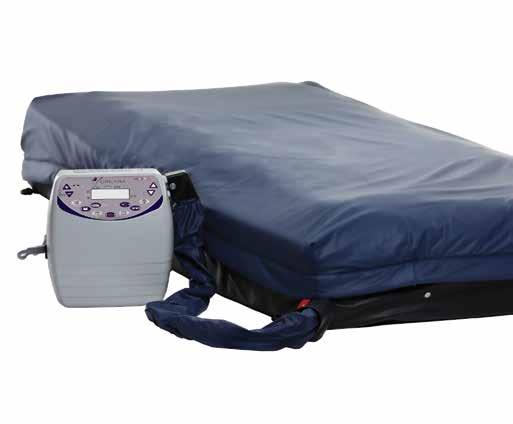











Where There’s Pressure Relief, You’ll Find Airisana® The Airisana® Therapeutic Support Surface brings a new design and unique approach to pressure management, injury treatment, turn assist and micro-climate management. Let us help you reduce rental costs and optimize patient care and staff workflows today! Advanced, Innovative Pressure Therapy Early Mobility & Bedside Therapy Support Focused Airflow Where Needed Turn Assist and Repositioning Intuitive, Touchpad Use Control Unit Extended Life Battery Backup Supports Sustainability with Exchangeable Bladders 1 2 3 4 5 6 7 Contact us for more information at 1-800-245-4636 info@encompassgroup.net encompassgroup.com 7 Reasons why Airisana® is Reducing Cost & Optimizing Care 5 Beds = 1 Airisana Alternating Pressure BED 02 BED 01 Pressure Redistribution BED 03 Low Air Loss BED 04 Immersion / Envelopment BED 05 Lateral Rotation © 2023 Encompass Group, LLC. All Rights Reserved | Lit. No. HC23876
Driving Value
HonorHealth’s Lisa Lavalette said value analysis teams are better equipped for today’s supply chain challenges.

Disruptions are here to stay in the healthcare supply chain. Yet because of this, hospitals and health systems are better equipped to deal with critical product shortages and disruptions than they were a few years ago. “Over the last couple of years, we have upgraded and improved our processes, policies and employee training to confront and manage these disruptions,” said Lisa Lavalette, clinical value analysis program director, HonorHealth in Scottsdale, Arizona. “Our supply chain team uses these processes to apply mitigation strategies. In addition, we are still evolving using data analytics to drive value and partner with our service lines.”
By having these processes in place, Lavalette said it has enabled the Value Analysis team to focus more on collaborating with clinicians versus primary sourcing. HonorHealth has Value Analysis teams that cover areas such as:
` Cardiovascular Services, Interventional Radiology and Imaging
` Perioperative Services
` Nursing
` Wound
` Lab
` Pharmacy
` Purchased Services
` Food
` IT and Corporate Services
Another area they have improved is their New Product Approval Process. HonorHealth uses a computerized tool for internal stakeholders and physicians to request a new product and/ or technology. The system is called Lumere, and provides the Value Analysis

VALUE ANALYSIS CORNER
April 2023 | The Journal of Healthcare Contracting 42
BY DANIEL BEAIRD
Lisa Lavalette
team with key information to make evidence-based decisions.
It provides a framework for evaluating products through cross references, basic product facts, product manufacturers, clinical purposes or applications, FDA approval pathway, recent recalls and associated evident insights. It delivers relevant research to key stakeholders via email and collects feedback through online voting and keeps them informed of the status of their request. It also provides peerreviewed clinical studies.
Screening suppliers
Many of HonorHealth’s suppliers are on contract with Premier, the IDN’s primary GPO. The GPO vets and credentials these suppliers in their contracting vendor selection process. For the non-GPO contracts, suppliers are evaluated through HonorHealth’s Supply Chain Value Analysis process. All suppliers must register through Symplr and adhere to HonorHealth Vendor Credentialing system procedures.
Suppliers work with HonorHealth’s Strategic Sourcing & Engagement team to identify new products utilizing their new product review process. “We are consistently assessing our suppliers,” said Lavalette. Some of the parameters they consider include:

` Years in Business
` Benchmark Data about the Supplier
` Supplier Diversity
` IDN Customer References
` Production Capacity-Supply Disruptions
` Sustainability
Future improvements
When asked what one thing Lavalette would change to help improve the value
analysis process in the future, she said establishing a clinical supply utilization management program. “We have elements of this program currently in place, but not an established program,” she said. “Having a program like this could provide an additional 7-15% savings in total non-salaried budget.
“We need to look at savings beyond price. Point-of-care is where we could be losing money,” Lavalette continued. “Looking into this allows us to understand
how our staff use products daily. We need to find and eliminate misutilization by tracking KPI comparatives.
“In order to optimize clinical utilization and to get next-level savings, we need to gather support from our leaders and clinicians by aligning with our Value Analysis teams. These teams can use sub teams to help deal with utilization misalignment in their departments. We must show clinicians the data through baseline reporting.”
The Journal of Healthcare Contracting | April 2023 43
Supply Chain By the Numbers
Facts and figures that highlight key supply chain trends.
BY JOHN STRONG, CHIEF CONSULTING OFFICER & CO-FOUNDER, ACCESS STRATEGY PARTNERS INC

` An estimated 3.5 million seniors had difficulty affording medications in 2019.1

` Why does new medical technology cost so much? In 2023 the “standard fee” for a 510(k) application at the Food and Drug Administration is $19,870, but the cost for Premarket Approval (PMA) and other similar approvals is $441,547. 2
` A recent survey of CEOs in hospitals showed that their No. 2 challenge is “financial.” Within financial challenges, most CEOs (89%) reported increasing costs for staff and supplies as most pressing. Now’s the time to treat Supply Chain Management as the strategic advantage it can be! 3
32% of the world’s supply of antibiotics is made in China. 4
What’s your sourcing plan for 2023 and beyond?
Supply costs per adjusted discharge rose 21% in 2022, according to a report from the Advisory Board Company. Drug costs rose 37% in the same report.5
Be prepared for the price tag! $700,000 for some of the most inexpensive to $1 million plus for Stryker’s Mako system.7
Health systems are increasingly seeking cross market merger partners, according to Modern Healthcare. More than 50% of 1,500 hospitals targeted by health systems between 2010 and 2019 were located in different commuting zones.6 There are 625 commuting zones in the U.S. Is your supply chain merger-ready?
Look for more ASCs purchasing these systems as they become the status quo in ortho services.
April 2023 | The Journal of Healthcare Contracting 44 Frontiers of the HEALTHCARE SUPPLY CHAIN Contributed by
Orthopedic robotics anyone?
90% of all purchasing leaders say their strategy for managing and procuring supplies has changed in the past two years. 72% of hospital purchasing leaders are working closer with suppliers now than two years ago, according to a report from Owens and Minor.8 Is it time for a more collaborative approach to buying?
A 2022 Deloitte analysis found that 72% of hospitals have at least one strategy to address social determinants of health and 84.2% of hospitals report screening patients for social needs.11
From 300,000 pounds to 150,000 pounds. State and federal agencies have been working with processors to reduce the amount of EtO released into the atmosphere annually between 2011 and 2020.12
$56.2B is the expected market value of endoscopy sales in the U.S. by 2030, double the $28.3B in 2020.9
Hospital supply expenses per patient in 2021 rose 31.8% for ICU medical supplies, and 25.9% for respiratory care medical supplies.10
Supply chain question:
Are you aware of how your suppliers and their subcontractors are dealing with the social needs of their employees? Many contracts have explicit provisions that bar practices such as child labor. Are you enforcing them?
The market for bioabsorbable implants in the U. S. is expected to grow about 9% annually between 2021 and 2030.13
About 7 million orthopedic procedures were performed in the U.S. in 2021. 47% were elective.
According to the Kaufman Hall “National Hospital Flash Report” for February 2023, purchased services expenses rose 23% from the same period in 2020.14
1 Keckley, Paul, “The Keckley Report”, February 27, 2023.
2 fda.hhs.gov
3 Becker’s Healthcare Review, January 23, 2023
4 Beckers Healthcare Review “Shot-down Chinese balloon may affect US medical supply chain”, February 15, 2023
5 Advisory Board Company © 2023 “An Industry Under Pressure”
6 Kacik, Alex, “Health systems increasingly seek cross-market merger partners” Modern Healthcare, November 7, 2022
7 Becker’s ASC Review “Robotics in orthopedics isn’t a luxury—it’s a necessity”, February 14, 2023.
8 Owens and Minor, “The State of Hospital Purchasing (Study), Published August, 2022.
9 Strategic Market Research LLP, June 20, 2022
10 American Hospital Association, “Environmental Scan 2023”, © 2023 by American Hospital Association
11 Accenture, Published by American Hospital Association, “4 ways hospitals can reshape their future” AHA Center for Health Innovation, December 13, 2022
12 Modern Healthcare, “A Dirty Business”, September 19, 2022
13 www.databridgemarketresearch.com/reports/us-bioabsorbable-orthopedics-implants-market
14 Kaufman Hall, “National Hospital Flash Report” February 2023 released February 27, 2023
accessstrategypartners.com

The Journal of Healthcare Contracting | April 2023 45
Supply Chain Visibility

Enduring challenges require new approaches.
When it comes to supply chains, there is no “new normal.” That was the biggest takeaway of HIDA’s recent Supply Chain Visibility Conference in Cape Coral, Florida. Despite the end of the COVID-19 public health emergency and an easing of supply chain delays at U.S. ports, every link in the supply chain remains potentially fragile. The threat of transportation challenges and disruptions are here to stay, and require new approaches in our industry.
New Acceptance of Uncertainty. Transportation experts warned that disruptions to global shipping will persist. Furthermore, the medical supply chain may never return to pre-pandemic standards such as just-in-time delivery. Stakeholders must adapt to a new “not-normal.” The pandemic was a rollercoaster in terms of demand, with exceptionally high levels for two years, followed by a sudden collapse in the fourth quarter of 2022. Shipping rates are likely to decrease while cancellations are likely to increase.
New Applications of Technology. Conference presentations highlighted ways that tech solutions are increasing supply chain visibility, from tracking shipments as they cross the ocean to sharing inventory levels at various locations. At the conference, one of the presenters shared their experience with a data-driven software company to create a crisisaverting, patient care–elevating healthcare supply chain ecosystem. As a result, they are better equipped to anticipate product shortages and make informed decisions on substitutions.
New Approach to Demand Planning. Demand planning must include market analysis and awareness of external factors, such as shortages of raw materials. Historical data about patterns or production and consumption are no longer accurate predictors of usage for medical supplies. Data sharing across the entire supply chain ecosystem can
lead to more accurate forecasting. Forward-thinking health systems are embarking on major initiatives to increase resilience by better understanding product criticality and risk. Additionally, they are identifying clinically acceptable substitutes for key items. Some provider supply chain leaders are collaborating with their suppliers to ensure these initiatives result in fewer back orders and stockouts.
New Partnerships with Stakeholders. Collaboration between the federal government and industry is stronger than ever. Conference participants included leaders from the White House Office of Science and Technology Policy, Strategic National Stockpile, HHS Administration for Strategic Preparedness and Response, and Food and Drug Administration. This level of collaboration underscores the ongoing commitment to maintain the strong lines of communication that were forged between the public and private sectors during the pandemic.
Most importantly, the key issue facing the medical supply chain is one of diligence. All stakeholders –suppliers, providers, distributors and government partners – must approach the issue of supply chain fragility with a renewed sense of urgency. Implementing key lessons from COVID-19 is critical to mitigating and preventing the next supply disruption. The industry should not be knocked off course again.
By
HIDA PRIME VENDOR BY LINDA ROUSE O’NEILL April 2023 | The Journal of Healthcare Contracting 46
Linda Rouse O’Neill, Vice President, Supply Chain Policy & Executive Branch Relations
Understanding the Evolving Laboratory Supply Chain
Health systems enhance their relationships with the right partner.
perspective making sure our portfolios have the breadth and depth needed to support testing.”
Berlin said Cardinal Health has added more products, product programs and additional service and/or cost options to its portfolio to make sure there is reliability on the supplies needed at the time the clinicians need them for testing, as planning has become paramount for health systems.

Cardinal Health ™ Laboratory Products and Services distributes to more than 6,300 hospital labs, hospital-owned clinics, and reference laboratories. It leverages the scale of one of the largest dedicated lab distribution networks in the U.S. to deliver best-in-class laboratory products and logistics solutions.
“Many health systems historically operated on a just-in-time approach, which was a standard practice until the pandemic,” Berlin said. “But then weaknesses in this approach were identified. So, by partnering with a laboratory distributor, healthcare systems can create resiliency plans on the necessary products they need within their facilities to keep patient care and testing ongoing.”
“There’s been an evolution during the pandemic on the importance of the laboratory supply chain and having a distribution partner who understands the laboratory from both a technical and logistics perspective,” said Emily Berlin, Vice President Laboratory Marketing & Aero-Med Commercial Sales and Operations.
“We intensely focus our time from a product management and global sourcing Emily Berlin

Enhanced partnerships, new programs
“Distribution has always been critical to a healthcare supply chain, but it is the recognition that a true partnership with transparent collaboration needs to occur between the distributor, customer and manufacturers,” she said. “Everyone is coordinated and communicating to make sure information is flowing seamlessly.”
The Journal of Healthcare Contracting | April 2023 47 Sponsored Cardinal Health ™ Laboratory Products and Services
To that end, Cardinal Health has offered some unique programs to its customers like the Cardinal Health Reserved Inventory Program, available for labs and health systems nationwide. It is individually tailored to participants and leverages data, such as historical utilization, to inform inventory needs more accurately.
This approach offers supply assurance for an often-unpredictable respiratory season further complicated by virus co-circulation.
“Exclusive programs like the Reserved Inventory Program, focus on maximizing the value of the program contract,” Berlin said. “Making sure as much of the contracted lab supply is going through the distribution contract creates efficiencies and supply visibility from a workflow perspective for those participants.”
Berlin adds there has been an overall greater focus on laboratory distribution adherence to standardization of formularies
“Patients are consuming healthcare like a product as testing continues to move closer to the home and more directto-consumer testing companies are providing services to patients. The services provided all originate with a laboratory test,” Berlin said.
services. Dedicated Cardinal Health Kitting Specialists work with customers to help them understand their requirements, such as collection protocols, product usage and standardization, to simplify the kitting process. Customers can choose the components, including Cardinal Health ™ Brand Products, packaging, labeling, and shipping options that fit their needs. From design to distribution, Kitting Specialists manage the process to ensure regulatory compliance and customer satisfaction.
An investment in customer experience

too. “This is really where supply chain professionals can collaborate with their clinical stakeholders to identify and implement product formularies across their network,” she said.
Specimen collection kitting services
With the acceleration of decentralized care and the growing focus on wellness and prevention, Cardinal Health has invested in its Lab Kitting Services business to meet demand.
Cardinal Health’s new Aero-Med facility in East Hartford, Connecticut focuses on manufacturing and distributing customized and standardized specimen collection kits. The 110,000-squarefoot facility replaced its previous 55,000-square-foot lab kitting space. It operates as one centralized warehouse, and both manufactures and distributes more than 50 million specimen collection kits annually to hospitals, reference labs and testing organizations.
Collaboration is the key to success for organizations employing kitting
Cardinal Health has made a significant investment focused on improving the customer experience and addressing supply chain resiliency and reliability. Investments have also been made in its quality procurement and planning systems and increased its inventory levels and days of inventory on hand within its network. One of the investments also includes a new, nearly 600,000 square foot distribution center opening in early 2023 in Central Ohio. Finally, there is a focus on broad access to components as a laboratory distributor, which is a differentiator for current customers connected to the Cardinal Health ™ Laboratory Products and Services part of the business.
“We view our role as enabling healthcare to be delivered; our customers count on us for our strategic partnership when it comes to reliability of laboratory supplies,” Berlin said. “So, our commitment to the healthcare ecosystem is something that we take very seriously.”
April 2023 | The Journal of Healthcare Contracting 48
Sponsored Cardinal Health ™ Laboratory Products and Services
Collaboration
is the key to success for organizations employing kitting services.
The role supply chain plays in laboratory distribution
Not all distribution is created equal. For 70 years, labs have relied on Cardinal Health for supply chain expertise, delivered standardization, savings, an expansive lab product offering and clinical relevance.
To deliver accurate test results that support patient wellness and early diagnosis, laboratories depend on cost-effective, high-quality clinical products and efficient operations. We have the experience, commitment, strategic supply chain partnerships and vision to propel your supply chain and the laboratories that you support forward.
We approach the supply chain proactively, valuing collaboration that enables visibility of inventory management and streamlined workflows that help reduce labor costs and mitigate supply chain disruptions and associated risks.
That’s why we’ve been the laboratory distribution and product advisor of choice for top healthcare providers for decades:
Lab supply chain expertise
• Proactive inventory management visibility
• Cold storage and special handling capabilities

• Managed seasonal demand
Standardization and savings
• Maximized contract value
• Data-driven insights
• Formulary implementation and adherence
Extensive diagnostic product offering
• >52,000 SKUs available
• Cardinal Health™ Brand product options
• Exclusive supplier agreements
Clinical relevancy and credibility
• Specialization by discipline
• Integrity and unrivaled depth of clinical knowledge
• Automation solutions to address labor shortages
© 2023 Cardinal Health. All Rights Reserved. CARDINAL HEALTH and the Cardinal Health LOGO are trademarks of Cardinal Health and may be registered in the US and/or in other countries. All other trademarks are the property of their respective owners. Patent cardinalhealth.com/patents. Lit. No. 2LAB23-2276659-01 (02/2023)
Scan the QR code to connect for a consultation at no cost to you.
Healthcare GPOs: Evolving to Address Today’s Cybersecurity Challenges
By Todd Ebert, R.Ph., President and CEO of the Healthcare Supply Chain Association (HSCA)

At the present time, it seems as though no one in the healthcare industry is immune to cybersecurity incidents. Public and private sector entities continue to call attention to the risks posed by data breaches and other cybercrimes. Not only do these events impose significant costs on healthcare providers, but they can also result in unauthorized parties gaining access to confidential patient information. According to IBM’s 2022 Cost of a Data Breach Report, the cost of a data breach in the healthcare industry increased 42% since 2020. In 2022, the average cost of a breach in the healthcare industry was $10.10 million – the highest average cost of any industry. Unfortunately, this is the status quo: the healthcare industry has maintained the highest average cost for the past 12 years.
Healthcare providers and the patients they serve can’t afford to be the victims of a cybercrime. Many providers also can’t afford to proactively address their vulnerabilities. The healthcare industry struggled in 2022, with many experts calling it one of the worst operating income years ever. Dozens of major health systems reported losses last year, due in part to rising expenses and poor performance in financial markets.

HSCA April 2023 | The Journal of Healthcare Contracting 50
Labor shortages are just one of the factors increasing costs for the industry, along with increased investment in cybersecurity. Investing in cybersecurity is both costly and labor-intensive, creating additional burdens for providers and health systems.
The post-pandemic world has also increased the number of cybersecurity vulnerabilities that healthcare providers must account for. The COVID-19 pandemic, which saw many employees shift to remote work and a spike in the use of telehealth, caused a rapid change in technology and data sharing, according to Healthcare Supply Chain Association member GPO Provista. Remote work can also make healthcare employees more susceptible to phishing, a type of cybercrime in which a fraudulent
email is disguised to look like it’s from a reputable or known company or sender. Phishing is designed to steal data or compromise an organization’s security –both of which are significant vulnerabilities for healthcare providers.

Healthcare group purchasing organizations (GPOs) can help ensure that healthcare providers have access to the most effective cybersecurity protection at the best cost. Many GPOs partner with IT suppliers and experts who have proven solutions that identify and prevent cybersecurity incidents. Maintaining device and information security is a shared responsibility of the manufacturers and suppliers of connected devices and services, as well as the healthcare delivery organizations (HDOs) that use them. The Healthcare Supply Chain
Association (HSCA), which represents leading healthcare GPOs, assembled key cybersecurity considerations and recommendations for medical device cybersecurity terms and conditions. HSCA encourages all stakeholders to evaluate their cybersecurity practices with the goal of protecting patient care and strengthening the industry as a whole.
GPOs have delivered critical costsavings to hospitals and healthcare providers for more than a century. In this high-stress and high-cost time for providers, the services and scale of healthcare GPOs are more important than ever. HSCA and its member GPOs are committed to expanding their offerings in cybersecurity and other areas to meet the needs of healthcare providers while continuing to help them access products and services at the best value.
The Journal of Healthcare Contracting | April 2023 51
Maintaining device and information security is a shared responsibility of the manufacturers and suppliers of connected devices and services, as well as the healthcare delivery organizations (HDOs) that use them.
Industry News
Intermountain Health announces launch of new biotech company
Intermountain Health announced the launch of Culmination Bio (“Culmination”), a biotech company developing an exclusive, anonymized, and de-identified intelligence platform that creates value for patients by developing novel clinical insights, discoveries, and care processes.
Culmination’s multi-modal intelligence platform provides its customers with access to omics-level data and a powerful insights engine for medical research, health data, and healthcare services. Real-world data and evidence generation tied to the performance of diagnostics and therapeutics is a core component of the Culmination intelligence database.
Cleveland Clinic and IBM unveil
The unveiling comes as a key milestone in Cleveland Clinic’s and IBM’s 10-year Discovery Accelerator partnership, announced in 2021, which is focused on advancing the pace of biomedical research through the use of high-performance computing, artificial intelligence and quantum computing.
Quantum computing is a rapidly emerging technology that harnesses the laws of quantum mechanics to solve problems that today’s most powerful supercomputers cannot practically solve. The ability to tap into these new computational spaces could help researchers identify new medicines and treatments more quickly.
employees also provided insights on their preferred communication methods for when safety issues do arise in facilities or in patients’ homes.
Key findings from the report include:
ʯ The initial and persisting impact of COVID-19 continues to threaten healthcare workers’ mental health and propensity for job burnout (77%).
ʯ As home healthcare services become more commonplace, 41% of respondents indicated they would worry more about their personal safety if they were to deliver care in a patient’s home versus in a traditional hospital/ healthcare system setting.
ʯ Like many in society, 40% of healthcare workers are concerned about the threat of an active assailant.
ʯ Respondents (54%) voiced that personal safety is a top priority for them to continue working in the industry.
quantum computer dedicated to healthcare research
first
Cleveland Clinic and IBM officially unveiled the first deployment of an onsite private sector IBM-managed quantum computer in the United States. The IBM Quantum System One installed at Cleveland Clinic will be the first quantum computer in the world to be uniquely dedicated to healthcare research with an aim to help Cleveland Clinic accelerate biomedical discoveries.
New report reveals healthcare worker’s greatest safety concerns Motorola Solutions released the results of its Healthcare Worker Safety Report after surveying 500 respondents, including doctors, nurses, technicians and administrators between December 2022 and January 2023.
Overall, the data shows that healthcare workers feel safe in their respective medical environments, but are grappling with safety issues that have dominated headlines in recent years. Those that have healthcare professionals most concerned include: patients becoming violent (72%), the impacts of burnout/mental health (61%) and active assailants (42%). Healthcare
ʯ Healthcare workers believe the right safety communications and training will help them to feel more prepared for emergencies at work. Respondents expressed interest in panic button technology or another 9-1-1 alerting system (55%), safety procedure training (51%), customized texts and/or phone alerts (48%), easily accessible, digital safety plans (46%) and the availability of a safety app with resources, plans and emergency contacts (44%).
NEWS April 2023 | The Journal of Healthcare Contracting 52
Setting a Solid Foundation for Better Care







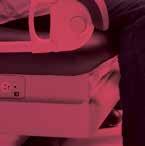





A fully connected point of care ecosystem integrates processes, equipment and caregivers to create seamless, well-coordinated patient and caregiver experiences. It provides a platform where organizations can leverage new technologies to improve adherence to clinical standards, efficiency (cost savings), and staff satisfaction for better outcomes.

Start here: midmark.com/seamlesscare

© 2023 Midmark Corporation, Miamisburg, Ohio USA





















































































































































































